It is volume 24 (23 22 21 20 19 18 17 16 15 14 13 12 11 10 9 8 7 6 5 4 3 2 1 0)
This is a part
of a raw and uneven journal of digging into the writing systems
from all over the world, so I recommend you to read the summary of this
work instead.
ba da
fu ſu
da = yes
fu = no
ba=mwa (приветствие: позитивное восклицание, поцелуй)
su (ссуRU) is "I piss" and "I'm affraid"(normative and coloquial meanings)
sru is "I shit" and "I diss" these two lines are of russian, but isn't it pride? no, it's the language I know the most, and because the origin can be in whichever family, I believe it will be common to each language on the planet, the mother tongue we all diverted from? Or mixtures of few mother tongues, as oghamic and syllabaric traditions could give birth to alphabet not being invented at one place.
Ogham is used as some ancientmost numeric system. Druidic it seems to be. And Runes were known to druids. Or did they use celtiberian?
B L N ~ M L N (при том, что S там вклинилось вместо N, что напоминает третью строку греческого и еврейского алфавитов. И почему бы не S? Потому что она не сонорная. А если оно было I M S? как в А М С[s] (A B C!!!)
bij dij
wij zij
bij is amongst wij zij hij jij?
I'm yet to decypher the nature of
ba da ve ze (ev ez?)
They are some short words,
but pronouns or prefixes? I guess I will find out soon.
I'm glad I appreached these depths.
I've got appreciated to these depths.
by die
I: be die
II: ve zee
III: ma na
IV: po to
V: fu su
antonymous phrases "come on by" & "come on die"
come on by ~ come on, bye.
by = bye, or rather bye is by or which way was they originating one another? buy? покупай хорошее пожелание. (в биржевой сделке это предсказание лучшего будущего)
I buy ~ I.. bye (I leave, I go, if you want to sell me something, sell it now. sail it now. сели её, слей её, сливай, целовай на прощанье, отсылай, от себя лей, отце лай, овце луй.. I am tripping too much today, what am I doint? why is it so.. unproductive. Maybe because I fourgot something)
א ב ג ד
ה ו ז ח ט
י כ ל מ נ ס
ע פ ר ש ת
I greyed away letters not present in other alphabets, and I got me
4ה ו ז ח ט
י כ ל מ נ ס
ע פ ר ש ת
I greyed away ת instead of ש because of sefer yetzirah, but the magical word א מ ת tells me that sefer yetzirah could be ..but ש is in the bible there, ת is also there around, but that эт seems to be of much less importance, a grammatic auxilary something. But then the text was without spaces between words, so it probably can be read differently. Was it written so as a poem to be read differently? Will I be able to do it in russian? Probably not, vowels are making the text more precise. And thus I have to check if this is possible by writing a text without vowels (and then I can read it) but remove the spaces between words as well, and let's see how it looks. This text, to be random.
gryd wy lttrs nt prsnt n thr lphbts, nd gt m 4
gryd wy ת nstd f ש bcs f sfr ytzrh, bt th mgcl wrd א מ ת tlls m tht sfr ytzrh cld b ..bt ש s n th bbl thr, ת s ls thr rnd, bt tht эт sms t b f mch lss mprtnc, grmmtc xlry smthng. Bt thn th txt ws wtht spcs btwn wrds, s t prbbly cn b rd dffrntly. Ws t wrttn s s pm t b rd dffrntly? Wll b bl t d t n rssn? Prbbly nt, vwls r mkng th txt mr prcs. nd ths hv t chck f ths s pssbl by wrtng txt wtht vwls (nd thn cn rd t) bt rmv th spcs btwn wrds s wll, nd lt's s hw t lks. Ths txt, t b rndm.
It takes effort already, especially I lost away is weaked. they should have left an j at least. But then in russian you can speak without mentioning the subject. And probably I know it about russian because I speak it, but in english I guess such phenomenon also exists,
grd w lttrs nt prsnt n thr lphbts, nd gt m 4
grd w ת nstd f ש bcs f sfr tzrh, bt th mgcl wrd א מ ת tlls m tht sfr tzrh cld b ..bt ש s n th bbl thr, ת s ls thr rnd, bt tht эт sms t b f mch lss mprtnc, grmmtc xlr smthng. Bt thn th txt ws wtht spcs btwn wrds, s t prbbl cn b rd dffrntl. Ws t wrttn s s pm t b rd dffrntl? Wll b bl t d t n rssn? Prbbl nt, vwls r mkng th txt mr prcs. nd ths hv t chck f ths s pssbl b wrtng txt wtht vwls (nd thn cn rd t) bt rmv th spcs btwn wrds s wll, nd lt's s hw t lks. Ths txt, t b rndm.
Город greyed? w is in in russian, but away in english? n is in now. it's interesting, but though it needs to be used to, it's still can be read, but let's combine it into one corpus and see what other meanings can we pull out of such text:
grdwlttrsntprsntnthrlphbts,ndgtm4
grdwתnstdfשbcsfsfrtzrh,btthmgclwrdאמתtllsmthtsfrtzrhcldb..btשsnthbblthr,תslsthrrnd,
btthtэтsmstbfmchlssmprtnc,grmmtcxlrsmthng.Btthnthtxtwswthtspcsbtwnwrds,stprbblcnbrddffrntl.
Wstwrttnsspmtbrddffrntl?Wllbbltdtnrssn?Prbblnt,vwlsrmkngthtxtmrprcs.
ndthshvtchckfthsspssblbwrtngtxtwthtvwls(ndthncnrdt)btrmvthspcsbtwnwrdsswll,ndlt'sshwtlks.Thstxt,tbrndm.
and I can easily see "This text, to be random", but to brain dome would be there, that lacks 's in between. to brand me.. They say tax it, to brand me.. It doesn't make sense, and thus it took some time to read the code. To know what he could talk about, to meet words you both knew, but use each such word only once, so enemies wouldn't use repeating sequences to single that thing out thus to get some frame of reference, and words would naturally repeat their patterns, even though some words were one letter,
grdwlttrsntprsntnthrlphbtsndgtm4
grdwתnstdfשbcsfsfrtzrhbtthmgclwrdאמתtllsmthtsfrtzrhcldb..btשsnthbblthrתslsthrrnd
btthtэтsmstbfmchlssmprtncgrmmtcxlrsmthng.Btthnthtxtwswthtspcsbtwnwrdsstprbblcnbrddffrntl.
Wstwrttnsspmtbrddffrntl?Wllbbltdtnrssn?Prbblntvwlsrmkngthtxtmrprcs.
ndthshvtchckfthsspssblbwrtngtxtwthtvwls(ndthncnrdt)btrmvthspcsbtwnwrdsswllndlt'sshwtlks.Thstxttbrndm.
grade.. walt? away(I would never have guessed it, I recalled it from previous thought) letters not present in the real phobia to .. and so I go off the track and I have to come back into decyphering the code, so I doubt people wrote like this dayly. But they could encode messages they already knew this way.
But of course it is merely a speculation, I just messed my head up with such mess.
внчлблслвслвблбгслвблбг
вот это гладко катится, интересно сможет ли читатель это распознать.
внчлблслвслвблбгслвблбг repeats слв (слово, соловей, слава, слива, слева, ослов) and it tells me that greek texts repeats "logos" three times.
logos читаемое? (just a guess, I don't know greek or latin well enough to tell, но было бы прикольно, если бы человек обращался к самому тексту самим текстом, заклинание бы воспринималось как живое (действующее) существо (опечатался суд.. судество, суть+ество, щ=ть? щ=с! в деском алфавите (детски алфавит, но дески алфавит, это разговорная форма, потому что дерзкий))
so,
א ב ג ד
ה ו ז ח
י ל מ נ
ע פ ר ת
orה ו ז ח
י ל מ נ
ע פ ר ת
א ב ג ד
ה ו ז ח
י ל מ נ
ע פ ר ש
א ב ד
י מ נ
ע פ ת
orי מ נ
ע פ ת
א ב ד
י מ נ
ע פ ש
י מ נ
ע פ ש
My guess is sefer yetzirah is the hidden truth, when א מ ת is folklore, or maybe even some psy-fi of ancient times, so it was distorted by the speaker who didn't want to tell all the truth for magic is sacred (secret) and mostly because (the reason I write this paragraph about what I say) it makes the third line more distinguished from the first one. first is not only voiced, but also plosive, so if פ is f (it is without dot, so f it is) and ש is s to ʃ, they are not only voiceless, but also fricative. And then I think it used to be א מ ת with ת read as th, which is how it sounds without a dot in it. And no insequrity about is it s of ʃ, but what made me think so is the similarity between ב and פ which makes me want such similarity in lingual department and I have it in ד and ת characters.
א ב ד
י מ נ
ע פ ת
but then AIO is a weird combination.. was it just IO? AIO was for Artificial Io? Could it be that I M N is how it all began?3 is a union larger than family? Was M replaced from this position because it was third, not second? Was the structure not distinguishing labials from linguals so it didn't matter? And began to matter gradually along the line of its development?
е ё ж з would be great counterpart of а б г д, if ё was closer to ю (literally ɪo), to Y to W (𐤅 is fonecian fo phoenician vav)
thot~тётя
я
е
ё
и
ю
י as `ёд?
א as Я!
ע as Y the И?
ю as U is past-T, and thus are not in the hebrew alphabet, probably because U=II, because Y=ij=ii, because Ю=IO, and is J actually O? is J йод and ё and thus o (that йотированный ряд гласных пришёл ко мне около часа назад в ванной в виде я е и ё ю, но здесь я запарился, и по привычке поставил ё после е, подобно доп.гласной в греческом. H~Ё?
but there was another revelation about H:
H voiceless letter, and as if it's Heer, His name is not to me memn to be mentioned
and it came from..
But here I checked the cardboard of today and it seems I didn't put this piece down. So let's try to rediscover it. H standing next to G makes it the C claster, GH, it's not velar column, it's C column, d is a form of c. is D being closed reverses the crescent? Or was it just reverse C before it became D to be more easily distinguished from C? And can you believe it! that reverse C, the Ↄ is..
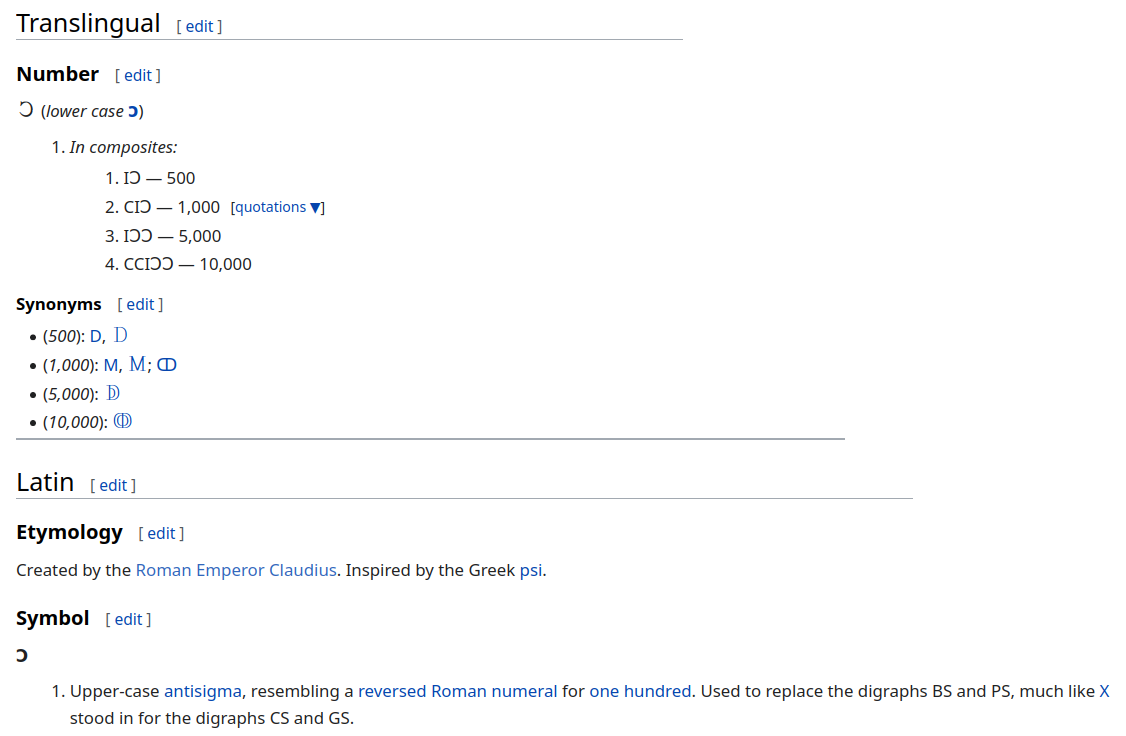
in relation to roman numerals, thei part is of CIↃ~M theory, so M delusion is probably starting at C.. at L! LCↃ.. L Г.. J? then T is the best I can offer for the other corner. J can have this corner, but then T never has the other bend, and J always has it.
CJLT? CVLT? ГVLT? гулять? водить круги вокруг деревни? от коло~круг? голи~гони? отпугивай (духов и живых существ) и хороводы вокруг деревни водятся посолонь для привлечения чего-то (дождя, быть может? но смерчи вроде крутятся в эту сторону, значит это вверх. А нужно вниз.
дождь~ненастье (ненастье~несчастье? настасья~несчастна? анастасия~богиня_счастия!) а- как отрицательный суффикс прибавленный к отрицательному суффиксу на~не, создаёт позитив? очень абстракция, отрицание отрицания, как давешно это словосочетание? (не верю что гегель его создал, он его наверное стащил) ана, анна, подобно بلى (ля=нет, баля=да) у арабов
لبی (лаба? лаби?) губа, губы (lip, lips) в персидском (и pulp, core in arabic, two languages so different, arabic/farsi are like chinese/japanese
𝕷 is a shape of L, I mentioned in those cardboards, ratioanlizing that L = J after I noticed that heil = hi.
иль им ин?
So is it how letters came out to be so different? Because the same articulation has different phonetic characteristic depending on which way the wind blows. And then orators invented continuous flow of speech. Apes speak on inhale too. Humans almost never do (they say some clicks can be considered inhaling, but those are hardly even known or hardly even truly inhaling.
And thinking that dogs are barking on inhale, I read of that, I tried that and dog reacted with more interest than before. So are they neither laughing nor coughing, but breathing this way? Some холотропное дыхание?
я а
е э
и ы
ё о
ю у
light
licht
might
macht
night
nacht
Do L M N as Light, Might, Night imperative the order of actions? Prohibiting noise after the dusk.
dawn [don]
down [daun]
(a sounds a о. о sounds as a?> just an illustration to see that vowels are not fixed. but i is always i, u is always u (if there's u)
Light Might Night Right
Light Left (if light is on, somebody's left)
Might Met? Mad?
Night Net (тень~тенета?)
Ought
Right Red? Rad? Rot? skin is red when the rot is in the process.
Sight Set!
Tight.. Tied!!!
White Wet? Wit!
Knight Known Knet? Knesset? Сеть знакомых?
Hight Head
Fight Fat? Fit? (fit=припадок, но может это притирка?)
Ate (I filled in a, e, o with somewheat similar forms for not having better ones,
Bite (but I'm not sure that they're to be here, they could be at, it, but then eat is is in different
Kite (spelling, so ate, eat.
Eat?
Fight
Hight
Khing Knight
Light
Might
Night
Ought
Quite
Right
Sight
Tight
White
from this not a large collective
I see similarity between bite and fight, between kite and hight
Bright
Draught
Fright
But then again, isn't spelling arbitrary. I really should not write here when I have nothing to say. But I use it as a draught. But I am not in condition to write. I must be asleep already,. I have some business this time another day.
ai will make this job with less pain and with some quality I will not reach without it.
I woke up at 1 am and I asked myself to know what letters are, and almost immediately I had a response to strat from syllables, the way celtiberian syllabaries have it, and I came to bo for boy and go for girl (g is d in russian, and gева[deva] is their girl) and it tells that BD(bd) were the only syllables, just as that greek myth goes.
Ba Da(Ga)
Be De(Ge)
Bi Di(Gi)
Bo Do(Go) boy/girl
Bu Du(Gu)
does b for male and d for female tells that women were forced to work, while male only had fun of hunt (thus justifying their leasure by bringing food) and it's time to get high. But firs I mention that I would have fosfenes phosphenes if my eyes were closed, but I looked into the night sky, and the image of the balcony door and everything around and through it went in quadratic segments of repeating ..brightness I guess, some fractal-like or somethingelse-like pattern. And that quadratness tells that the world could be cubic after all. My world that is. I'm yet to live in rhombic dodecahedrons, then we talk. My guess is the neuronet in my head may rearrange into four to eight synapses instead of 6 (or, it the neuronet is two-dimensional, it will surely become of triangles instead of squares, and thus where squares had four contacts per knot, triangelic structure will have six. Angle=Angel! No way these two words of glorious abstractions are not related. Let's get higher and ponder further into that syllabic concept.
Ba Da(Ga) bad / gʌd
Be De(Ge) beats / gets (бьёт/деет? бьёт/даёт? (кто кого нагнёт тот того ибьёт))
Bi Di(Gi) big / little
Bo Do(Go) boy / girl
Bu Du(Gu) bull/cow (in german cow is Kuh[ku] (bull is Bulle (поле:?)))
So I drew that table before I got hight, now I did and the first revelation which came to me was Tarantino being forced to film Jackie Brown to reduce the furor from black ciommunity that in Four Rooms the only black man was mutilated (and now I see that the only reason for him to film it with himself as an instigator and real Bruce playing himself, so the events probably happened during Pulp Fiction movie, so he had to explain to the audience why on earth have they cut of the actor's pinky. They destroyed his career that moment. Yes, blacks are not very bright, but it's not a reason to to play such cruel jokes on them. And the porter who they bought to make that actually crime was justified by the events in the movie. And if it was to cover the crime, the storyline of the most fucked up events in the porter's career.
Porter dark brown bitter beer brewed from malt partly charred or browned by drying at a high temperature. is thus made of burnt malt, so if you happened to burn it, you can add the coal to porter (but who drinks it? those who don't know how it's made, but them I'm making up things. If you're productive without weed, don't smoke it. Not until you're certain that the previous charge is gone. I had a чистый пиход (с утряни кусок сна к себе в эизнь затащил)
портье как слуга пьёт что попроще? porter~испорченное?
Be and Du are the opposites. Qu the Cowe is the last letter? are them B T the ᛒᚦ
ᛒᚦare21andthenextletteris0,,orE?orO?e=0?andIis1and if I=1, then E=3, but was 3 two? if 1 could be drawn as ↄ Lower-case antisigma, resembling a reversed Roman numeral for one hundred. Used to replace BS and PS, much like X stood in for CS and GS
was x ↄc?! then ↄ was k and thus they becan to di.. gin in begin is can? begin=becan, be able (begin to do = be can to do, and when modal verbs were told to be special (for stylistic or colloquial goal) the combination of those modal verbs going as normal verbs became other normal verbs? I'm just suspecting it, I havent' ttest iot it o with data and computing powers, for that get the )
Ba Ga
Be Ge
Bi Gi
Bo Go
Bu Gu
bull gu (bull is boy, gu is kow)
boy~bull
girl~cow
rl as double sonor. and v is not sonor, but w sorta is. со нос
сова
owL
ov is the same? om? aum?
aum
с aum [with aum] -> сова
owl <- aumил [did aum]
(only those square brackets are semantic, not phonetic. I need other brackets, and I don't like how {} look. but I have to get used to them, because they're the only other brackets on the keyboard, and I should be lucky they even have them)
be[bi]{був}
ото и обо
об~по
но от и до почему антонимы тогда?
потому что не до, а то!
от-то как в слове отодрать.
those { and } look like owl's brows is brows using the same ow owl does?
yes, that change of font colour works as protection against copying, which I don't like, I endorse copying, but I also like how that change in colour works. If they want to copy it, they should use the html of mine, it's fee (I wanted to say free, and nwo I want to (nwo as a typo of now is awesome. now own nwo) discover the connection between fee and free. is r rough killing of that word, to show the opposite meaning? as less today, and that r resembles l of less, 'll makes it "not yet" I'll do it = I didn't do it, well in case of dealing wtih a king or other authority)) to download, and so you have the pictures too.
dog, cat, horse don't have не слагаются по роду (на самом деле по полу, в роду разные пола, мне это всегда выносило, что за тупость) но в русском таки да, наверное и в английском да, я просто его недостаточно хорошо знаю.
horse = force (но вообще-то power, но я их синонимами считаю, в русском "сила", но я ничего ближе чем "седло" не нашёл в русском, но седло это именно что коня/лошал коня/лошади аттрибут.
пёс/сука тоже бубную делает мужской, а язычную женской. Что идёт в разрез со многим что я говорил (т.е. я не правильно читал? факты могут ли друг другу противоречить? В генетике можно прочесть один и тот же текст тремя различными способами, и каждый способ будет правильным. Три, ха?

Sample sequence showing three different possible reading frames. Start codons are highlighted in purple, and stop codons are highlighted in red.
molecular biology is an interesting subject I reccommend you all to dive in:
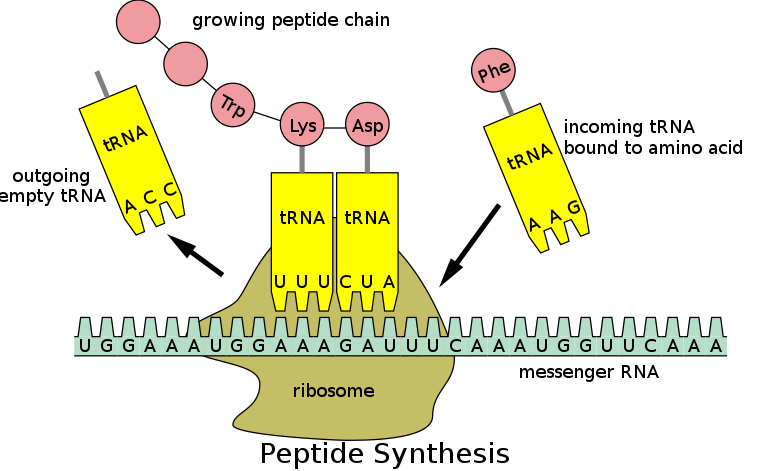
And this is the philosophic question I dare to solve today: how exactly did this machinery came to be.
I know how the elementary particles have came out to be, from resonating fluctuations of vacuum swirly onto itself given certain ammount of time to grow resonating frequencies, and the frequency of one area influenced frequences of the other one, so the resonance were global, universal, and in infinite time we had enough time to grow what we can see around and within us today.
So now I'm thinking of the following storyline to link those rotating thing into molecules. And only then will I be able to solve biochemistry and then molecular biology I will be able to visualize probably only with the help of the neuneurocortex technology.
neuneuro is righteously read by g.translator as нойньюро
нойньюрокортекст (т was demanded by russian's feeling of the language)
is text tagsed? is tag a mark? every letter is tag? as a signature? as a cliche too? избитая фраза? (another translation, related to ярлык)
so text is tags, each word is known, but their combination makes up unique text.
just as text is tags, note is of know? note=knot? word=note? I warned ~ I warded (worded)
word is wored? worried? wore уже прошедшая форма. word~wore (носил? смысл несло, несёт смысл? word makes sense indeed)
word заворот? (ишь как завернул) оборот! (оборот речи)
warn~worry
word~worry
ward~worry, care (carry~wore)
worry~scare~сказать?
worry~волновать
weave~wave?
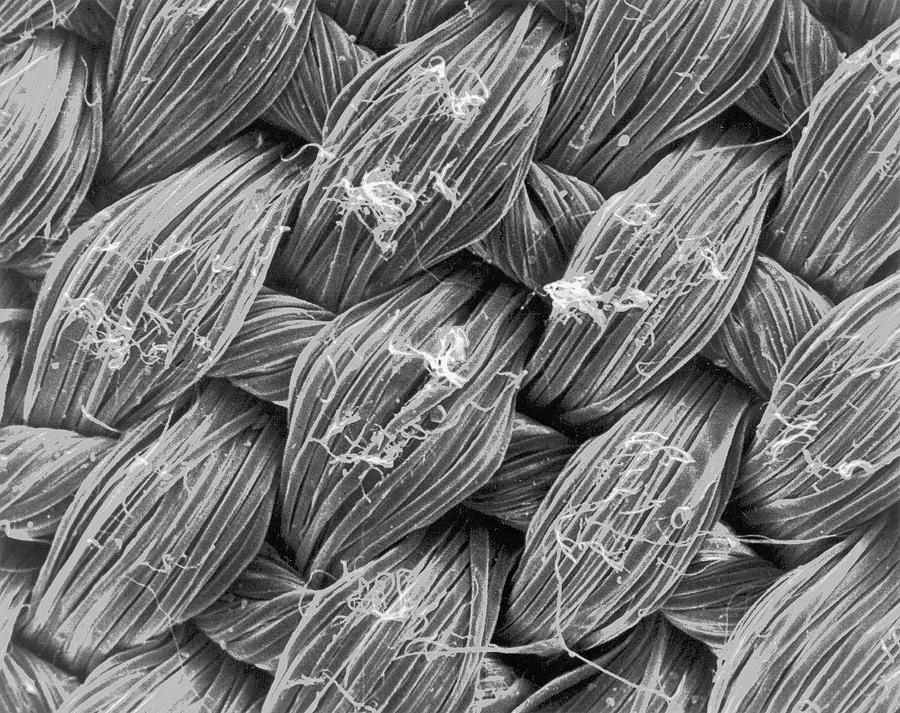
weave.. wave..
w as in away, out[ʌwt]
v as in в {in}?
au=o, thus out is от
от = of (out = from? from = of room?)
ethicacy ~ efficacy (because these two words would be hard to destinguish, the first one is ethics)
airy~fairy
chord is actually accord (not one cord, but few)
三菱 (three diamonds) [mitsUbishI]
菱 (diamond) [hishI]
二菱 sounds as не беси (but vowels are sounding uniquely, in russian this voice would be taken as foreign, (feigh~foreign? fuck or reign? reign as the opposite of faint? faint~feigned? failed to be rained)
faint was feigned?
feign ~ fake (feign=faking (not king but fink (think? he thinks he's a king? could it be a trick of the pretender? he feigned, yes, faint (if it exists, it is probably in the english literature, I wish I can have the spheric bath for both. bath4both it's a great marketing slogan))))
but 2菱 is read nihishI. is it a bug of additng words together or are there two ways to read it. And nihishI will also be understood, but correct way to say is nibishI 3菱 (is read as san hishi (san is chinese word for 3, japanese is mi, mitsu (tsu как в русском слове единицу, остальные числительные этот суффикс не используют вовсе, но есть церковное слово (и может лишь потому не устаревшее) седьмица)
седьмное сегодня говорят не седьмица, а семёрка, не единица, а единичка,
двойка двоится? двоица?

Энд ай уос лукин фо троИца, and was shocked when the result hit me like.. I didn't know I knew this word, and I think I did. How could stress make it so unrecognizable to me? I should play with stress to test all the words.
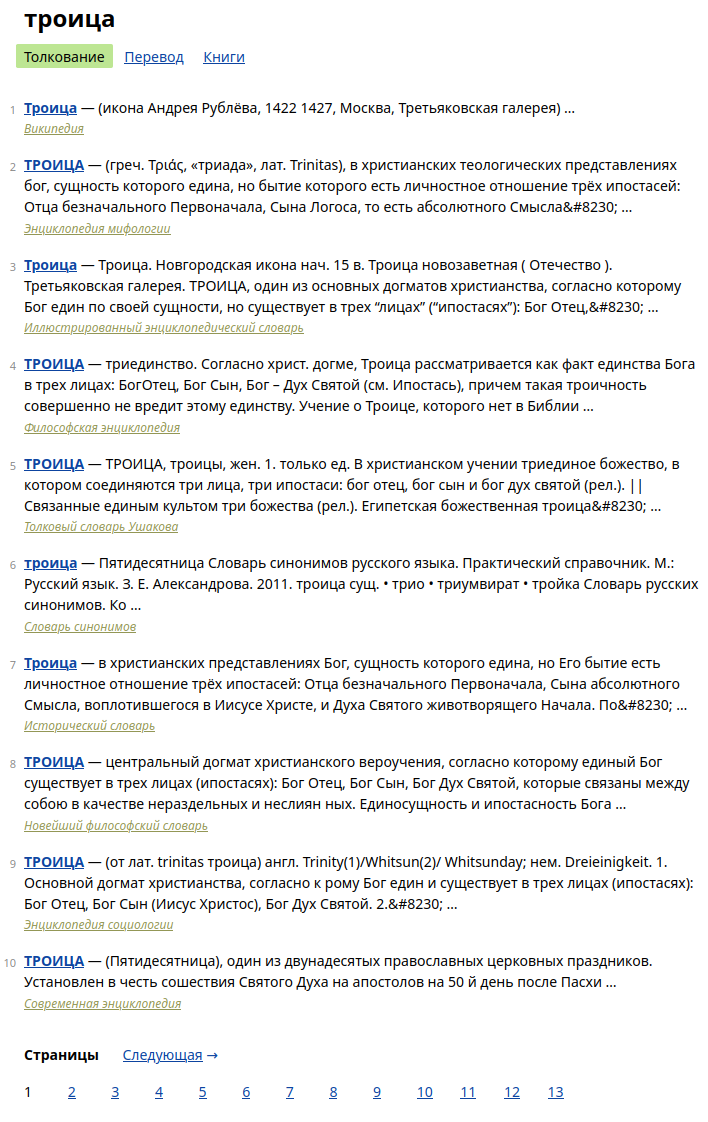
and that site mentioning Pythagoras sparked my interest, and I went on collecting information:

четверица — четвери́ца (Деян.12:4 ) четверка солдат для дежурства в каждую из четырех страж ночи (двое внутри, двое снаружи тюрьмы)
пятица не находит ничего, но я знаю пятиться и пятница
шестица отправляет к инглингам, словно кроме них такое слово никто не использует, но я посмотрел шире, и да:
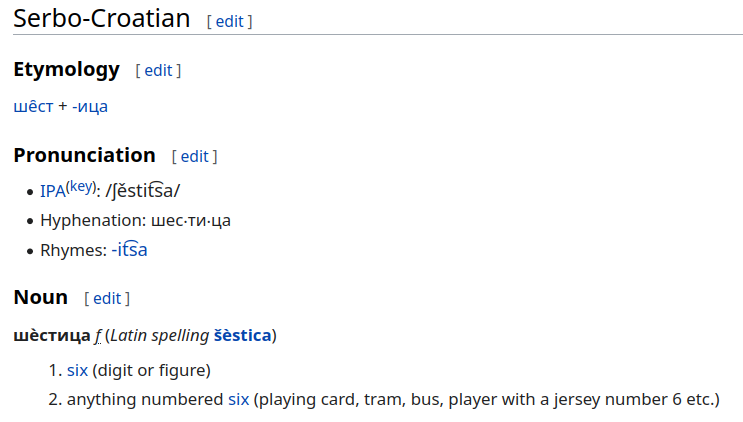
а инглинги выдумывают глупости:
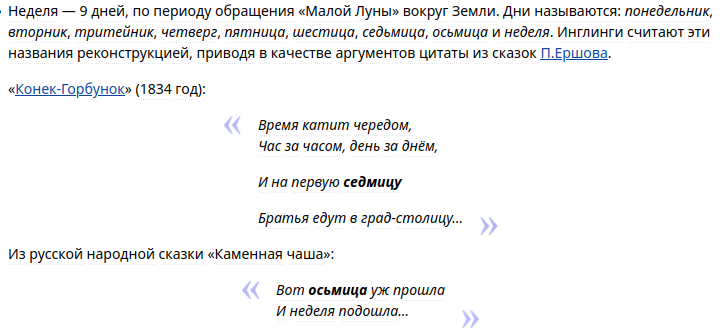
потому что

а русская сказка просто переврана, скорей всего. седьмица там было бы в тему, но может это магический элемент, надо смотреть контекст, вдруг там штырит рубит валит поправляет и ломает.
So that itsu suffix is not foreign to rus,
rus is "'re us"
're us
we, rus ~ we're us?
Is it poetry or actual architecture of the ethnic terms? names are connected to nation names, ярусский, indeed. But I went deeper, because names to nations were given before all those ruslans walking this earth today. So what is each nation stand for? Мы? Люди? Так их чаще всего этимологизируют.
Тогда бы нации соседних стран назывались похоже. И первый же пример лидийцы/лицийцы подозрительно напоминает слово люди. Как и латы/литы. Русы брутализованное люди? R~L and C~D
руки~mani (на русском рука, manus на латыни)
цикада in serbian is цицада, but is also read as цикада (ц is like c, both k and s (in russian ц is ts, but they transliterate c with ц: cent = цент (but native speakers pronounce cent as sent))
center is sending office? where mail comes and they sort it and send it further.
so is it etymology of centre of of cent? sent? or center cents (or sends? did they take one hundreds so they became known as center? and did send came to be out of that center? середина начинается с се, имеет и р, и н, и д вместо т, только в другом порядке, но мы видели такое с морф=форм,
сердце от слова средина? центр? cor[kor] o носовое?
центр~контора? контора~конура? окно то же кн имеет? контора окон тура? это поэзия! но иногда она прямо в цель
контора кантует? катает? (катать малявы можно, подобным конторы и загнимаются.
волкRU = вовкUA
(but in ukrainian it sounds like волк, I wonder if it's some w, the ł, but in polish волк is Wilk, but вилка is widélec, minuscule form of widły [vidwы]
wision (wise vision. if I ever use this word for a slogan, I should consider the we⋅sion part, wishing part, etc: with ion, )
тринадцать могло считаться несчастливым числом, из-за того, что оно похоже на двенадцать (два не спутать на три, потому что бывают два, бывают две, но в двенадцать это е безударно, а потому редуцируется до и (и на часах показано лишь 12 часов, американцы даже могут и не понять словосочетание "тринадцать часов"
B Т
B T
B T
(and three vowels shining on them in differnt colour)
let's see
aMs times those BT:
Ba Ta (B D,T)
Bm Tm (V,W ?? and only the alphabetic position helped me to know that it's Z, там=there, тьма=zwartheid(чернота, а не темнота, так что натяжка, и с чего бы нидерландский? там~тьма(где не видно!)))
Bs Ts (F Ц)
I like how T and W leave space after commas
Восстановление Музейона (храм муз, настоящая научная школа)
три отдела: буквы, цифры, ноты, в каждом три музы (три матери, три maður(three humans))
p d of yin yang can be also seen in пук и дух (попа и голова. п снизу? как в восточных алфавитах.
ACB is the sequence? ASM? did sefer yetzirah's tradition
CВА would make a rad sequence, because СоВА is Owl in russian. C~O, o~w, В~l(in cursive and in ł (and in украинское/русское verbal suffix of male in the past. л in russian, w in urkainian, which reminds that ł, and female in the past uses the same surffix la in both ruusian and urkanian (those typos tell a story: ukrainian is ur kaanian (cohen~каин?)))
У Адама и Хавы (Евы) было три сына. Они упомянуты в Торе. Известно, что вместе с каждым из сыновей рождались и их сестры-близнецы. Эту информацию дает нам внимательное прочтение (на иврите, конечно) четвертой главы Берешит (ст. 1-2). Здесь, при упоминании факта рождения Каина, а потом - Ѓевеля (Авеля) в тексте стоит соединительная частица винительного падежа - эт, которая употребляется перед названием какого-либо известного объекта.
So, את ה is эта (bible at first didn't have spaces between words)
"er waren geen spaties tussen woorden" doesn't pronounce n in waren and woorden, and this is a french influence, I suppose, or both french and dutch are under the influence of the same tradition, but french adopted that tradition much more than dutch.
בראשית ברא אלוקים את השמים ואת הארץ places stress at the end syllable in each word, except in those two main words SHaMAiM & AReTS
ב ראשית ברא אלוקים אתה שמים ו אתה ארץ
And I can see not only эта in that אתה, but also the: ה is e, ת is t, it's only natural to suspect א to be Хh and th being affricate, and e and th were two elements which could be placed whichever
In words like this/theese and that/those plural form has the element of doubling: in theese that i became long i (probably because there was nowhere to pitch, and the is taken for the middle ground between this and that (some abrupt the (when people mumbled to high lie (to hide lie I wanted to say, and what is that?!)))
ShaMan does have something to do with shamain, with fire and water. man is of water then.
Shaman is fireman? Жертвенник, где поддерживается огонь? Ибо надо делать воскурения по часам? Чтоб видели соседи, что там селение? Огонь для утяжеления облаков дымом, дабы выпал дождь в долину.

that ח ט י כ ל מ נ [hin] sequens sequence is somewhat alphabetic, which makes it interesting (is מ ~ נ?)
But then I see that I forgot ט and thus this is all not that important
БыВ ГДЕ Ж Zie и к
БыВ ГДЕ ЕЁ ёж ..
БыВ ГДЕ ЕЁ ЁЖ
БыВ ГДЕ ЕжИк Мне о просто
БыВ ГДЕ Ж Zie И КоЛоМ оН По РоСТУ
БыВ ГДЕ Ж З(zitten, зад свой положил, sit~зик? слишком натянуто, не по размеру.
же~аж~ёж~ожог, не кусая, ёжик ожигает, лучики как у солнца. hedgehog is a special animal, god gave him needles as if to tell everybody not to toutch this dedgehog h-og
A Б Г Д
Е В Ж З
И МН Л
О П К Т
у Ф Ш С
Абе Г-д
ЕВа ЖиЗа
Имануил (or ИМ МаНи Лей (но это поэтический разбор ещё более чем Имануил))
ОПеЧаТай? Обкатай? or is IMN Amen which ends the prayer, and additional letters made it not mnemonic anymore.
A Б Г Д (O П К Т) whisper
Е В Ж З (Е Ф Ш С) means the same
И М Н (as if somebody understood truth and sealed it in the word
B L N or B L S resonates to that И М Н & A M S
Why did I use russian H in there? it is H the h I type. Why? Hands, why,
Адам~Ад
Ева~heaven~нЕба
(ева женщина? неба невест?)
Ева дЕва девушка девчушка девочка девчушечка девонька девка дева (de Eva)
Aдам пАцан (по отцам (отец от слова уд? древнее ли это слово или относительно модерНовый эвфемизм? поцан от слова поц тогда будет созвучно: поц имеет тот же от как в слове отец, уд:
поц=поотцу))
хуй ~ אui (ахуй, а у и.. странный порядок. такая гамма? у огама (гамма огама!))
Ау был крик человека!
Ау как первая гамма: человек зовёт людей криком ау А У отражают друг друга У=U=V (в древности V была и для U и для V и была последней буквой (как ижица! но в латыни гораздо раньше это было так, до расцвета Рима ещё и может в начале где-то (там много диалектных вариантов, латынь лишь государственный в отличие от остальных)
Ау удивительное слово ещё и потому, что не так уж много слов из гласных:
ау её и о я (её used to be ея)
Иеоуа! ИЕАОУ (хроматическая гамма суха, иеоуА :а как луч надежды, на подъёме)
IEOU было до внедреничя А? ieou как сложная запись слова её? нет, выдумываю,
IEOV have V as number 4, which goes to that 365 theory.
then why isn't E 3? why isn't O 0!
I O could be the initial dao, yang and yin, even though here 1 looks more like I of yin. How do I even know these two are the true name? I must know chinese to tell. Or I may look for synonyms in the neighbouring languages, to research these words.
Агу, первое слово ребёнка (которое не слово, а просто агу)
АУ первые две буквы и Г первая согласная, т.е. восточные традиции правей, Labies firest is probably european courtesy reform we don't know about.
ɅV [au]
ɅГV [agu]
и эти три угла вызывают третьего
ɅГLV or ɅLГV?
ɅLГV
и я подозревал что Г = C = С[s] может быть Алсу было каким-то именем уровня Анна
но нашёл лишь, что оно означает розовый цвет и алую воду (розовый - разбавленный красный)
Су вода? Ал алый?
LVГɅ love goes? лови уходит (remember this, that carpe diem)
LVГ ~ LMN
LɅVГ (lover?)
ГLɅV вот это будет у меня на кабинете.
ГLAV как согласные вначале, гласные приложением в конце (но могут быть и в начале.
AVГL Anglia is first association. August's Land
LVГɅ ~ Луга
VГɅA ~ Угла! и это именно то что это есть.
Уга как отвт на Агу. В значении Ага! ɅNГLe reminds me of ν[n]
Луга~Longa?
ANГeL
four archangels remind four corners of the square or four ends of the cross? four sides of the square?
AνгLe Aνgel
and because L is Λ and Г is 𐤂, I suspect them to be the same angle. No matter which way you drew it, angle is still an angle. And thus N, V, G, L are all the same letter? and A too? v is ʌ in bus.
NAГLый VAГNый
VoLГɅ VLГɅ
were water and fire two elements and V being water, and crossed shape A being fire?
It would be much more to the point if Ʌ would be fire, and water would cross out fire. But some traditions tell that water was the first. Which is natural. Nothing is born from fire, fire is a destroyer)
VГLɅ.. but if we rotate it clockwise..
VLГɅ or LГɅV or ГɅVL or ɅVГL.. and AVГ is very abc-like. And L is next to D (by both t looking like l and Λ looking like Δ (is Λ fire and Δ air?) is V water, and no fourth element (the earth is combination of different elements) so no letter ∀ .. but then that's right, air is not Δ but A
A Λ V
but alphabetic ordre is A V Λ, but no, maybe Λ=Г=N, лгун?
and V is the final letter of archaic latin alphabet (not speaking of ижица)
A at the beginning of the alphabet and V at the end of it remind the forks at the ends of ogham:
᚛ ᚁᚂᚃᚄᚅᚆᚇᚈᚉᚊᚋᚌᚍᚎᚏᚐᚑᚒᚓᚔ᚜
and this similarity would be even more spectacular, if we remember that ogham (and runes) began at the bottom of the stone.
Язык зверей и птиц = язык змей и птиц (письменный и устный)
курсив змейка, подобен верёвке, подобен узлам.
Thinking of how ogham used the same staff to draw the text, and runes (ruins) did it only occasionally if ever at all (I don't know how much I can trust that testimony on the internet)
ANГA ~Анка ~ Анна ~ Anna ~ Она (см. японское они (ср. с дэвами (хорошие в одной религии, плохие в другой, god in english is гад in russian / бог in russian is bog in english))
Ангел имеет Ан ту же что и Анна (бог. Он? Она?)
Ангел божий посланник. Гел посланник? Гоинг?
ἄγγελος и есть посланник (вроде как.. согласно словарю. но там же ἄγ = св. и этот акроним помимо прочего к архангелам применяется (святой Михаил - это архангел Михаил, святой Гавриил - архангле Гавриил, и так далее, потому немного заносчивой кажется традиция канонизировать служителей церквки как святых) γέλιο значит смех, ἀγγελῐ́ᾱ значит message, command, в общем послание.
a typo of an anon made me think.. males make, females 不make (don't make)
(japanese fu = no (in chinese it's pu) and is cognate of cynologist "фу!" {don't}
better ~ бАто (заебато) (когда услышал слово "бато" в первый раз (в 80х) оно мне жутко не понравилось, что за абсурд, какое ещё бАтый? Только сейчас увидел, что это слово батЫй (но сопоставив его как эвфемизм слова заебатый, изменил своё мнение на нейтральное.
член часть
ЧΛС? (н~т? both'e last in their lines)
чресла
телеса
тела's?
телаs!
телеса это не части тела, это тела́
тёлки ~ тушки
ёлки ~ ушки?
телега тележка ка=ica? oh! graphic! graphic tells yes, because I came here from the side of g being palatalized before к
телега te liggen (чтоб лежать, чтоб ложить, чтоб лошадь, лега~лошадка? лег(ног)leg лягать ногами, battle with boots? boots to beat? бьются (дерутся. потому и кованые!? потому и лошадей копытами вооружали? И лишь затем поняли, что вообще в копытах сносу нет ногам)
копытко
колодка
коняжки гоняшки конь къ+на
knight konight? konig's? king'th (with king? with in russian is с[s], which is close to th)
with (c) c: (is is shortened as 's, and that 's is also genetivus, and plural — a similar similarity may be seen in russian: суффиксы а и ы обозначают и множественное число и родительный падеж:
димы = dimas & dima's
города = cities and city's (но здесь русские ударения ставят в разных слогах)
и если представить ту 's как с(with) то тоже будет иметь смысл: дима и ~ димы (нескоько от димы) города (а~и, with~of? с~из ~от (is~with?))
белки мелки
japanese letters may tell that letters up to 4 are very similar to roman. 4 in a square to show those two as the same dign? как лига в нотах, как .. над гласной во французском,
but then 5 is like hindu 5 which may indicate that roman numerals were reflected into chinese or latinen took that system from china before it was influenced by indian.. by buddism, I suppose)
And then they go off the rail completely, maybe 六 was five the reformers didn't know of, but just pushed it aside with their 五.. or couldn't they be switched for some reason? because 五 looks kinda like 5, but even more so it looks like 6
g.trans bugged and translated семь as セブン, and it cought my attention, because セ looks like 七 (the actual seven, chi in chinese, nana in nihona, but it is a coincidence for sure)
sure ~ sue (for sure is sufficient four court (the sue)?)
八 is 8 and it seems like a diagonal stroke stood for 4, and it didn't matter which way you draw it, as long as it is a diagonal.
And diagonal for 4 would make sense if it was
12
34
but it is impossible to have a magic square with only four numbers. with 9 though.. and more:
1 is around at the centre 3 to four times out of 6, and the other two are having 1 at the corner, and I suspect that half even squares have 1 at the corner, those who are divided by 4, and then square of four elements (2×2) has to have the one in the centre, but there is only corners. So is it also why there's no magic sqaure of 4 digits?
raiment as the obscure (actually, it's bibleic, thus obscure only to a foreigner) form of word clothes
относится это слово к слову rain? типа дождевик. Не от дождя ли одежда защищала в первую очередь? одежда должна защищать от дождя, иначе смысла в ней не много (скрыть срам жировых складок да фонючего отростка? фонючий это опечатка, да какая, оепчаточка.
vraiment (воистину по французски.
Я вспомнил как у меня испортились отношения с одноклассниками: училка спиздила мою книгу (выгнала всех на перемену, запретила заходить в класс, сама там запёрлась типа на проветривание, и после перемены книга пропала. Возможно, она забрала её в педагогической цели, раз я притащил её на урок и открыто читал её, я такой был, непосредственный. В общем, она походу дала мне понять, что это кто-то из одноклассников. А книга была очень увлекательная, всадник без головы.
Не отдавайте детей в школы! Мне это не было уроком, я не понял нихрена, только сейчас восстановил по памяти что там скорей всего произошло.
Обучайте детей самостоятнельно, вы добьётесь больших успехов. Стимулируй детей читать, писать, рисовать, считать (желательно, на практике) интерес к науке подогревай. А большинству этот интернат лишь отвращение к наукам вызывает.
ɅМN of amen we know as ΛMN of LMN
ɅMS of sefer yetzirah is probably ɅMT of the word truth written on the golem to make him alive.
And all three forms are correct, they're just differently inclined, -en, -es, -est are suffixes.
AM is the root. OM.

O reprezentare din secolul al XVII-lea a conceptului rozicrucian despre Arborele Pansophiei , 1604.
those Bi Ti caught my attention, I think I'm going to dig into that book from 1604 some day, but now I'm jsut tripping on, anybody can do it, my task is to bring about the ideas nobody else would.
and the man inside of the ball is my long time aspiration, I suspect it to be a way to reach immortality,
leaf trees are deciduous deciduous deciduou deciduous trees, follar trees
dollar tree is offered for those who look for follar tree, so I think it's the first to go. Or au contraire for that dollar follar ..identity maybe? dollar was a leaf? but how can I change the initial letter so easily?
follar is to fuck in spanish, so imagine my shock when I went to google. oh~! wow fuck!
follar trees is the first to go.
Deciduous is опадающий (т.е. лиственница тоже deciduous, хоть и хвойная)
Coniferous (aka conifers) is the opposite of deciduous.. in russian translation of english text, but then there's Larch which still breaks google's translator in late 2022, making it output лиственные хвойные деревья (т.е. одно не исключает другого, и лиственница словно хвойная, но и лиственная, в английской номенклатуре так, потому что они не называют нехвойные лиственными, они называют их опадающими, от cado бросать произошло слово decidere (to fall down or to fall off) which could explain the word decide, of the lot thrown, is it how people of the past made their decisions? If the lot said "no" they would do something first, and then threw the lot again. And I read that it's not allowed to throw the lot more than three times a day. Or is the third lot too much? I think in some baltic tale the third time was taboo. Just throw the lot and go. Or don't go and do something first, then throw again to be sure you knew the will of gods on the subject.
but then it doesn't break it when it's in the context:
Larches are deciduous conifers in the genus Larix, of the family Pinaceae (subfamily Laricoideae). Growing from 20 to 45 metres (65 to 150 feet) tall,[1] they are native to much of the cooler temperate northern hemisphere, on lowlands in the north and high on mountains further south. Larches are among the dominant plants in the boreal forests of Siberia and Canada. Although they are conifers, larches are deciduous trees that lose their needles in the autumn.
Лиственницы — листопадные хвойные деревья рода Larix семейства Pinaceae (подсемейство Laricoideae). Вырастая от 20 до 45 метров (от 65 до 150 футов) в высоту[1], они обитают в большей части более прохладного умеренного северного полушария, в низменностях на севере и высоко в горах южнее. Лиственницы являются одними из доминирующих растений в бореальных лесах Сибири и Канады. Лиственницы хоть и хвойные, но лиственные деревья, осенью сбрасывающие хвою.
not bad, huh! they do understand the text, and without the context лиственные хвойные деревья is a great choice.
and it's funny that volume 22 was written within two weeks of October 2022 (volume 20 took a couple of months in the summer, and it took so long because I lead some social life, and even drank alcohol beverages a couple to several days straight, I had a dear guest and had that дебош который застил собой работу на пару месяцев, и спустя пару недель после которого я увидал вот это:
(я о неё говорил в томе 21, так что там быть может более точная дата явления, можно посмотреть в разбитом чёрном айфоне, которым фоткал в это время (но это ремарка для профессиональных редакторов и историков моего путешествия, у которых будет доступ до всех сохранившихся материалов)

эта радуга здесь, чтоб показать, что высокие вибрации со стороны света. Быть может радуга воспринималась как фронт боя сил света с силами тьмы (и здесь её с правого фланга начало затягивать облачком (бочок которого виден на фото) и если это какой-то знак, то надо бы мне опасаться тьмы с правого фланга (не скатиться в оголтелый имперский нацизм, не принуждать людей к подчинению, но любовью побеждать. В любом случае, в моей памяти оно такое, я сокрылся на пару минут в соседнем здании, и выйдя увидел что радуги не было. И вот она есть, в реальности была гораздо красочней, не скажу что в 3д, но в 3д по факту, ярче была в реальности. контрастней, вот правильное слово
Дополнительные цвета именно со светлой стороны несут очень благую весть. Всё будет хорошо.
Силы света (люцифера, бога-сына) перемогают силы тьмы (сатаны, бога-отца) и это естественный процесс из тьмы хаоса к свету порядка. Но я думал бог-отец это порядок, а бог-сын это бунт против порядка. Да потому что порядок бога-отца не от мира сего, сатанинский по сути, поперёк естеству, страхом и болью карает он врагов своих. В то время как Иисус проповедовал Любовь.
запуган запукан (это откуда-то из поэтической волны, но это вполне может быть этимологией (тот кто пукает пугает, человек боится что гость обосрался (не ну а чо, прикинь какими дикими были манеры до изобретения культуры. язык-то и у животных есть))
the form cado gets in deciduous allows me to declare падай и садись не только вариантами разговорным и нормативным, но и дублетами, и там и триплет, и катрлепт и пентант (sounds like педант, энд иц ту зы пойнт. пентет напоминает паштет, что не в тему) so we need the common term. and the common term is acognates (неузнанные. и позволяет рисовать другие уровние: bcognates for russian and ukrainian morphemes. ccognates for russian-english cognates, dcognates for russian-hebrew morphemes (but this is only so in the current taxonomy, my guess is hebrew is much closer to russian in the в (english in is much more deviant from russian-hebrew ccognzte. a b c makes sense because соромно от срамно с большей вероятностью исторический этимологизм, чем соромно и sorry, которые больше похожи на когнату, если смотреть с украинского, нежели с русского.
еврейский суффикс им скорей всего когната с русским местоимением им, потому что это местоимение множественного числа (а им в иврите это суффикс множественного числа) и третьего лица, впрочем это уже ..но впрочем тоже, очень подходящее местоимение, чтоб стать глагольным суффиксом. дать им = датим (даём? но в ём это м от мы. мы и им как антонимы! первое и третье лицо. И видимо он это носовое о, и это м of Oм
of = об = около = о
круг это крюк (по дороге сделать круг = сделать крюк)
а если эти = - в математике из химии? или в химии из математики?
= двойная химическая связь, прочная
- одинарная химическая связь, отнимаемая? отнимающая? совершающая хим.преевращение?
или лучше - водородная, а = ионная.
hydrogen bonding, interaction involving a hydrogen atom located between a pair of other atoms having a high affinity for electrons; such a bond is weaker than an ionic bond or covalent bond but stronger than van der Waals forces.
кукушку когда научили спрашивать сколько жить осталось, я не останавливался когда она останавливалась, а спрашивал "а дальше?" и она продолжала куковать и я продолжал считать. Это учит детей считать? Это даёт надежду, что
ку подобно собачьему гав (тоже бессмысленное, тоже похоже что автоматическое, но я так самонадеянно говорю, что бессмысленное, когда они
Evacuation is опорожнение (vacuum = пустота) и это действительно основное значение, жееесть
г ~ r also because r in russian looks like p (even in cursive russian р[r] looks like english p[p]
and russian cursive г looks like the second part of those p's:
there's no proper (even latin) cursive in unicode, but then fraktur can tell few stories:
𝔞𝔟𝔠𝔡𝔢𝔣𝔤𝔥𝔦𝔧𝔨𝔩𝔪𝔫𝔬𝔭𝔮𝔯𝔰𝔱𝔲𝔳𝔴𝔵𝔶𝔷
is 𝔶 drawing a link between y and ŋ?
is 𝔳 a form of 𝔬 as ו is?

here I has screenshot of how it's in the firefox, because the k of theirs is very interesting, and though I have spoken about it before, I must return to it to tell how that k looks like modified t
in seamonkey fonts nothing of this kind can be seen:

just in case, here's it's in unicode and plain text for you to play it with (maybe in your browser it's depicted in some other way)
𝔄𝔅𝔇𝔈𝔉𝔊𝔍𝔎𝔏𝔐𝔑𝔒𝔓𝔔𝔖𝔗𝔘𝔙𝔚𝔛𝔜𝔞𝔟𝔠𝔡𝔢𝔣𝔤𝔥𝔦𝔧𝔨𝔩𝔪𝔫𝔬𝔭𝔮𝔯𝔰𝔱𝔲𝔳𝔴𝔵𝔶𝔷
𝕬𝕭𝕮𝕯𝕰𝕱𝕲𝕳𝕴𝕵𝕶𝕷𝕸𝕹𝕺𝕻𝕼𝕽𝕾𝕿𝖀𝖁𝖂𝖃𝖄𝖅𝖆𝖇𝖈𝖉𝖊𝖋𝖌𝖍𝖎𝖏𝖐𝖑𝖒𝖓𝖔𝖕𝖖𝖗𝖘𝖙𝖚𝖛𝖜𝖝𝖞𝖟
here's an example showing how that 𝔨 works:
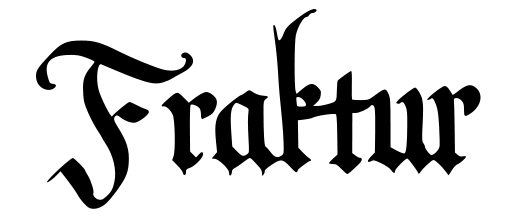

f is dashed s, not t!!!! and yes it resonates to the ams~amt thing
it was abc, d is ck
(dick did? fucked)
I use images like the following one (somebody made a comparison) as raw ore
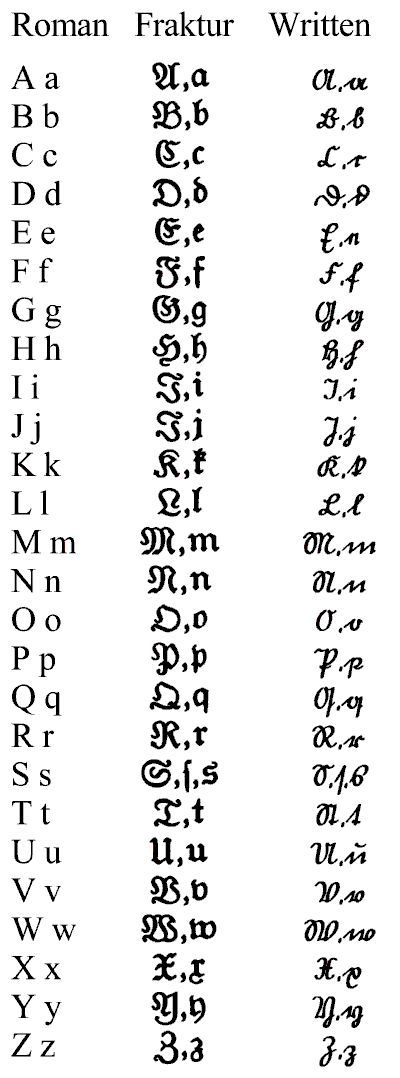
Both fraktur and cursive exposes the actual nature of a and a.
In fraktur u is n upside down, and in cursive u is n̆.
and that makes their u remind й, but now N is И and is a spelling of N, and thus english N is russian И
their variant is much more nasal. And it reminds me that юсы ~ йотированные гласные? но какое отношение нос имеет к этому. Н и есть нос, а ОС это греческий суффикс, типа латинского ус.
Ус is moustache (I believe moustaches to be simple sentences with us the ус. like my уст laces (ус=уст? уста от слова есть? mouth mes (мышь точит, mouse=mouth, yes it is why we dislike mice: because they steal our food. those retarded animals decided to be parasites. рты и людей сжирают? земля питается такими ртами? они и есть земля? одни из многих представителей, как разные типы клеток в человеческом организме, так и биосферу можно рассматривать как совокупность клеток в виде отдельных ососбей и органов в виде популяций, )
Cursive S looks like 6, isn't it lovely. And yess, I take it as S standing for S56 (5 or 6)
because 7 looks like T? no, it looks like Г and then I recall that ᛚ stands for l, and T is indeed ᛐ
T as ᛐ is more likely to be 1, because ᛒ is 2
maybe that is how it was for some time, and gave birth to eastern syllabic sequences,
S looking like 6 also resembles hebrew cursive shin



thus when they're all in one screen I can see more clearly: interesting that the ,,and I thought for a while, and I had nothing to day say, I have to ponder on it for awhile, these forms could be arbitrary.. could they? The german territories are top-notch civilization, they are literate since antiquity or maybe even from prehistoric times. Which is weird, for no such thing as prehistoric times is, but then I could use the term to the historically accepted history of writing. And I do not challenge the official narrative in this one, I do though in the booklet and somewhere in these drafts in previous volumes.
What I find interesting is that european cursive mostly goes counter-clockwise, but it didn't harm their ability to prosper, while arabic going from right to left draw their handwriting clockwise, but it didn't haelp them either.
Fraktur confuses me as is it even authentic and not arbitrary? But some mighty artists have derived it. I will return to it later (S in cursive may be explained by the fraktur. A also correlates. And it's funny that it reminds U. Yet what has caught my attention is idea of cursive in other languages:
It was a good year for common sense. In 1875, Denmark changed handwriting models, replacing blackletter cursive by copperplate. This extended to its Icelandic dominion, where copybooks and model sheets in the new style were in short supply. Eight years later, a much needed handwriting manual by Benedikt Gröndal was published. The old style and the new are similar in appearance but have different letterforms.
The upper of these samples is blackletter cursive. The lower is copperplate. Both were written with a pointed pen. The two styles look alike at first glance, although most of the letterforms are different. From Almanak Hins íslenzka þjóðvinafélags, Copenhagen 1877.
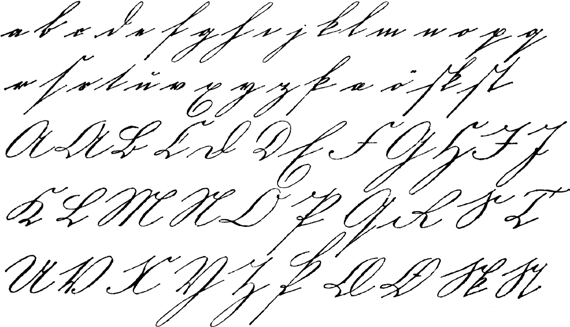

The new version didn't have C! ABD! As in runes! that letter after z is þ (not ϸ, if I used it instead of þ somewhere, excusez)
They also didn't have Q, probably to compensate the lack of C and still to arrange into axial symmetry, with all those variants (variants of E, are they the same letter or two separate ones? Like variants of s in minuscule cursive stand across the single S.
those examples of icelandic (actually dannish) cursive is from the book with such ISBN:

(I acquired an isbn form my book, but because it mentiones religious subjects, it is not wearing a barcode, but technically isbn is the number compatible with barcode, so I have it but without those additional 666. And I wonder what does the 50000 stand for (it's too large to be a number of copies, and I wonder if the barcode below 50000 denotes 50000, yet no repeating pattern which could go for 0, so do they use some other numeral system or is it completely not related?
And why I brought it here is the illusion of colours which some gaps give me, I think I've shown you the disks of black and white deciradians,
deca ~ deci (deca is 10, deci is 10th)
ся сей (не внушает больших надежд на различие в слогах, но в то же время говорит что три материи, а гласные лишь падежные окончания, придающие доп смыслы (не дека, но деки (десятая) не дека, но деси (с is both s and k, and that is how ancient pronounciation was, savage))
Those codes being compatible with ISBN made me think of what could it mean, and I know that it's international book number, but what could S stand for, and the context insisted that it's satanic, but then I recognized it as standard, and it made me think that stan is satan. and standard is satan's art (indeed formalization is the opposite of art, and if this world is in the hands of Satan, the governmental structure is genuinely satanic, and thus the Son of Man (сын мужика)
standart where satan is stan makes det svenska namnet sataniskt
satanist and sataniskt sound exactly the same (exactly!) yet the first is satanist, and the second's satanic
relates satan to stone, and indeed the opposite of the living matter is mineral, but then we can see that they're essentially the feeding substrate (being dissolved into soil, or somehow being enough for mos, which is satisfied with some water and some sun. so water is the opposite of stone, and water is the substrate, so it could seem to the ancient people but now we know, that water is only medium, what it brings matter more, but then it is also the medium within cells, so water is life is not that much of an exaggeration. Where there's water, there must be life as well (whether in form of animals coming to drink, or of planets afar, but they couldn't know it, but their ancient wisdom dictates it to be the case and we're yet to debunk it (bunk in debunk is probably bank, so debunk is the opposite of "take it to the bank" (did they make bets in banks? to ensure the loser pays what he gains, they could place both bets in the bankcell, and the condition of the sum given back would be the condition, that the person should bet the winner of the debt, or that they both should have come to bank, and to agree on who's the winner))
and banks could do it for free, because in some special cases they could keep the money (if one of the parlay (also simply lay, bet, betting, wager (пари is money in makedonian (yep, makedonian is a slavic language))) group died before the collecting, for example)
And paleohispanics used to use elements very similar to runic tradition: dots between words (or are they punctuation marks?) and lines drawn for writing, I think latin texts didn't have it, but I could be wrong, but I effortlessly googled and it comes that ancient traditions didn't use lines between the lines (as we don't have them now, because we dont' need them, but notebooks for schoolboys all have them)
.jpg)
I can only guess why most of the text is strokethrough, it could be a long letter, edited to leave only name and "goodbye" or something, but as I said it's just a guess.
And the similarity goes deeper: here's clearly paleohispanic, and it goes in snakey way, which I only saw in runic texts, where it's rampantly so:
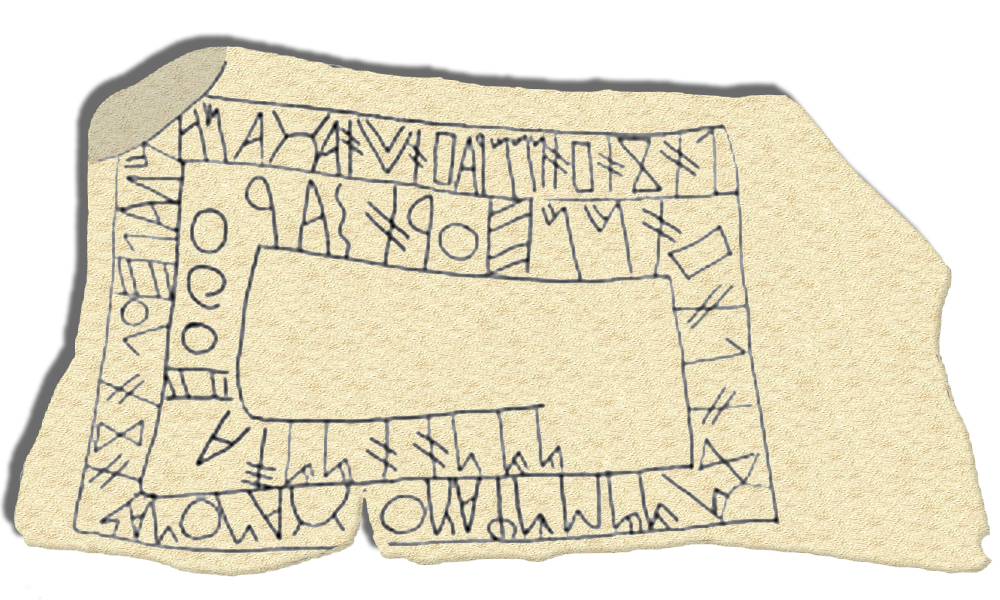
those two images link to a weird page calling translating Écritures_paléo-hispaniques as Палео-латиноамериканские писания, which is some new form of comedy created by ai-translator unintentionally, I guess again, but it does seems so. Only I think northern runic snakes began at the bottom of the text, and here we can clearly see that it starts at the top right corner and goes left, which is a surprise, I thought paleohispanic went left to right. But I was only half-right:
Письменность делилась на две крупных ветви:
южная (надписи в основном справа налево на тартессийском и иберском языках); устаревшие названия — турдетанское, бастуло-турдетанское письмо (не следует путать с «турдетанским письмом» — тартессийской разновидностью ливийского письма, известной по надписям на монетах)
северная (надписи слева направо на иберском языке)
and the paleohispanic I have shown in vol.7 without having much to tell about it, now I adore how they began it with LMN (is it a whim of the researcher or does it go deeper than that? the fact that it's not exactly LMN, but lmm̄ and only then n, makes me believe that it's genuine, though I could be wrong)

and the way it starts with the AɅ'like shape and goes on straight to labials, and the way that first M reminds ᛘ makes me come, and the second M reminds V, the same ᛘ, and the other shape identical to ᚴ maybe holds the key to k standing at the M's place.
And then ti reminds ᛉ [z, s] (notice that it's not ᛘ and hispanics seem to distinguish between the too better, which makes me think that runes are derived from paleohispanics, which derives from some other syllabaries. we yet to discover the further past, I know only geographically distant syllabaries like old-persian cuneiform, but there must have existed some shapes in between, I suspect some proto-tifinagh, looking at the paleohispanic te/de shapes. and ku/gu, and pu (as if for пуф) reminds ancient egyptian p the 𓊪 (and some other noticable elements (interesting vowel shapes) I spoke before, I will have to have these pieces sorted, so I can have plenty of books: a book on paleohispanic, a book on rainbow, a book on politics, a book on whatever other topic I can pull out of it, plenty of subjects, and plenty of books on each subject can appear of here)
holds ~ has
The way that table keeps the BCD order is fascinating, and Tu being the final letter is great and it also being Du and looking like Δ (and with that central stroke it can be seen as T too, as a mushroom. The last food you should resort to? Death of mushrooms was? танец/dance as well, some mushrooms are better than the other, so that dancing shrooms are ta/dah!)
And then that tu/du syllable looking as egyptian pyramid makes me think of it as of a burial hill, and makes me suspect the origin of this thing in Egypt, and then I was looking for 𓃀 and one form of pa/ba does look like legs. Are ti/di arms? or is M arms, as in manusLA
And if the other M is also manus, then L-shape must be legs. And it would justify it's initial position in the light of 𓃀 (as humans master walking before they master working)
I noticed that HI is another inverse sequence of H being 2 and I being 1, and this sequence is next to 321 of EFГ. And four letters before it made me think: is D 1? it doesn't make much sense. is С 2? Г was 1 just before, so it makes even less of a sense. is B 3? it does look like staved 3. is A 4? and A does look like 4. hm.. and it all begins with I, aye.
B being the first letter in sacred texts cannot be adequately translated into english: in there it's I, aye.
But then the first ..let's call it "large word" begins with b.
IEAOU sequence (it's from the booklet, I'm not sure I gave it here, it's aboth about AEIOU being EIOUA or IEOUA in judaism, and that from there just one step to descending pentatonica or IEAOU) combined with that B being the first consonant gives me
Bi as the firs syllable. And it fits for Big. then the opposite is tiny.
Bely Terny? Back Ta...? Boy Corl? Bu.. Tu..? nah, probably not.
In being the first word is more fundamental as german Im
And it's suspicious and very interesting that g.translator doesn't offer me im, but only in, bei, auf, mit, zu, seit, but I know there's im in german,
and it is interesting that einstürzende can be split into einstürz and ende, because thus that ende is into and ing-ending too, and that ing-ending is recognized as "in the" and to~the because both are te in dutch. but it's not the einstürzende neubauten I used to adore, I thought it was in the next song, but it's am, even more interesting, am~im, huh, the first letters, hm..
And it's natural that I thought it was im, because it's not in the title, and it shows how arbitrary the vowels are. And if there's one thing to hate nick cave for (other than promoting heroin and having name similar to nick cage) it's that he spoilt Blixa, Bargeld used to be awesome, not anymore. I should look deeper into FM Einheit's art. And though blume is a great thing, he had to keep it for his solo (it alone would make his solo performances a hit, it would not be compared to his other work. And he would do it truer if he was allowed all the artistic freedom (the departure of two of his best men definitely fucked him up. too much ego makes you ugly, and so, it was a turn astray, and honestly even though I enjoyed Tabula Rasa, it was wrong even there, and the first track was embarassingly annoying even then. I now I cannot listen even to their old material, because lots of how much of retarded normie shit is in there. I tried to listen to haus der luge, and the first track made me hate the blixa's vocals. But Halber Mensch is all great, you should check the whole thing that previous video is from, it's all awesome, and I think the next album is also good, and I never listened to it, doing it now. And now I recall that экзотика about nick cave (see, soloist, and the badseeds (as if he is the good one)) was shown on russian (or still soviet) television for three or more times in a row, because authors left when free television in russia, and thus perestroika, collapsed.
but then I look in reverse, and it translates im as "in the" and there I can see my am, and ins (as if the merged in the into one ins. I do have to know german, like wtf, it's even embarrassing at this point)
Aorta begins interestingly, unusually, so I separate that vowel dyphthong from rta and it made perfect sense: in russian рта[rta] is genetivus of mouth (of mouth, that of becomes -а) and mouth is рот[rot] and rot in english is гнить[gnitt] in russian, which could be related to гниды и гады, но я это только счейчас заметил, а до этого смысл был в том, что кишка называлась рот, и была гогнатой слова root (bloody root indeed this time)
И я всегда хотел знать почему сердца черви. И вот это пришло и стало понятней, но что это значит? аорта была словом, обозначающим сердце? сначала я думал что ао = eu (real, true, good) which separated aorta (aorteria) from gut (root from gut, g is г (г is for говно, as russians probably mocked the reformers who placed G from the 6th (or 5th?) position (6th! G ~SC ~ S, second row is fricatives (and in short hand twig it's only 4321 321 21 of ABCD EFГ HI and something tells me (that г thing) that there's a reason Г doesn't look like 3 (or is it three dots?) Г is great 2, two strokes, people draw not with dots. D is one as ᚦ and ᛒ is 2, then ᛆ is 1, as it looks. What? it only tells ᛆ was added later, when one was conceptualized, chances are numbers began at B and A was added later (or is B 3 and A 4? That could be addition of those who conceptualized the 4th matter, and before there was only two! because graphically ᛆ is not of the same deck as ᚦ and ᛒ, who thus explain graphic similarities between A and Д, a and d, maybe even 𐲁 and g, which then remind me of similarity between 𐤀 and K, is it the same A/Д thing? (is it ад when you don't know А from Д,) even a Q, a q, so is it the same a~d thing for c is staveless d. Ди, джи, какая разница в самом деле (но фонетически они as far as could be)))
Что приводит нас к следующему вопросу: кашель первый голос? зверь выдаёт себя голосом, и кашель непроизволен. ка это жизненная сила в древнеегипетском. ki, ци. qi (ki romaji, ци русский, qi english)

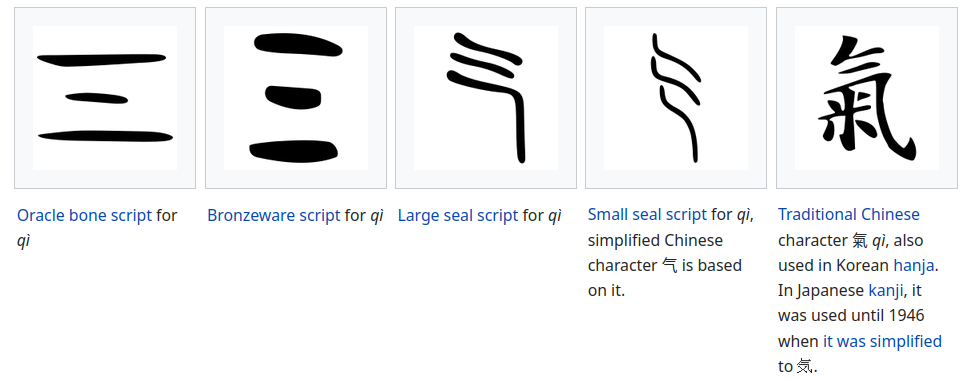
They probably speak of japanese. Because in chinese it is simplified to 气, which is pretty much back to the roots (if we can trust sinology, but see, this cynicism, this revolutionary spirit is what may make people think I'm insane. How dare I actually, don't break all the beliefs, let people hang onto something. But see, this is how common people are different form scientists. Good scientists want to come to the very root of the being, they want to see everything for what it is. But isn't seein believing? Inner see, yes)
belly is belly because navel is a bell button, and so it is belly button (not пуп, but пупок)
near ~ nigher
🜂 B D
E F Г
Ж H I
it maybe not clear what I had in mind there, here's that shape of Ж I had in mind:

though with Х they went too far, no russian would actually recognize it, but as for Ж, that wouldn't be mistaken for anything else. it's as if Ж is a double Ш, just as B is double P, as ...I think I had more examples of doubling denoting voiced variants of voiceless single ones. W could be double V along these lines, if V is read as f as it often is in german, for example. And here that Ж is not only double Ш, but also double H, if that H is read as Ш, which it could (adn it does in some languages I do not remember)
HEARTWORK is THE ARTWORK
(the becomes he in hebrew, and probably in many languages in between)
some mighty words I used in correspondance: aeon of abundance
aeon reminds aeiou too much to be a coincidence (as if that order may change, but it will take a whole epoch.
abundance reminds ab and d (d is for dance, and let's collect the magic words for each letter)
bibimus cantato tanz
очень весело живём: пьём танцуем и поём
пьём поём подъём
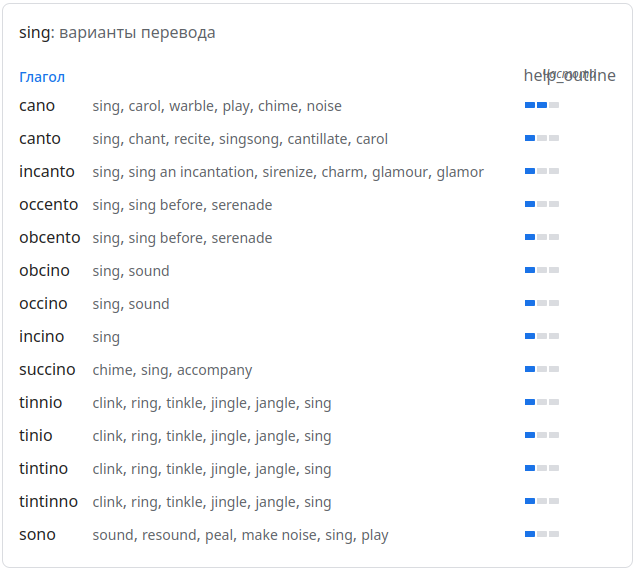
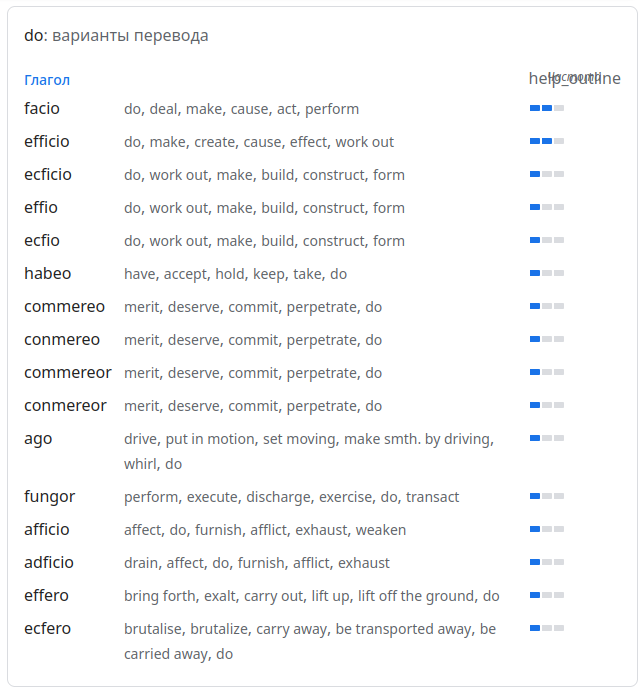

three out of four verbs I took were latin, and of course it is latin! Latin was the language of the prechristian empire, surely they have to keep the record of the previous civilization. I hope so, either way it whether does or not, but we have to entertain this possibility first.

and here we can see, that the most translations of dance start with s or t, which correlates that tanzen (and even dance) thing.
lsd trip as short form of trapudio?
saltare is another form of "to dance" not present here. so except ballo and other complex form they all are of s or of t (are they the last consonant, because делу время потехе час?)
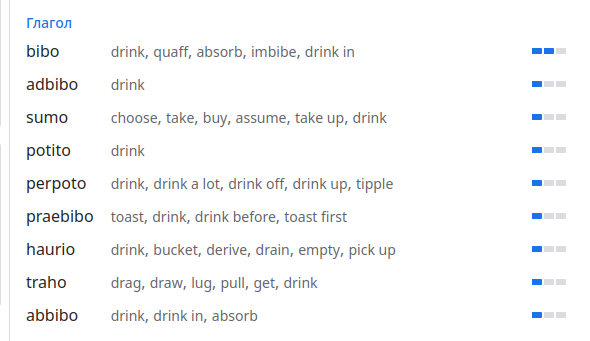
potito is cognate to russian пить [pitt]
so I can see two main forms: bibo and poto, adbibo, abbibo, praebibo, perpoto are their variants, and other few words are probably figurative or something.
dies is days in latin. as if some doctor gives somebody "days" he also tells that he "dies"
Uyghurs is read as wiggers in english (in russian it's uygurs with long u and short y)
спокоен ~ с покоем?
безумен ~ без умем? без ума?
красен ~ красим? (покраснел покрылся краской?)
бледен ~ бледим? бредим? болен?
беден ~ без денег? (это прекрасно, даже если этимология ина, это прекрасно (и ина (краткая форма слова иная) это тоже прекрасно) и кажется даже верно: без денге → бед → bad
Что значит НЯК? в бедняк? подобные слова есть у японцев: нин, дзин, ша, джа, и тому подобные
В субкультуре, в которой это слово имеет значение, НЯКА означает something nice, и
per se ~ само по себе ~ by itself
per ~ by? orthography can be at hand: bij → i = ɪ = ا, j = r (I typoed r as u, yeah, right finger wanted to type the r, and it types l instead. I should invent a keyboard better than queerty. d
п, d, r would be under the right palm
л, s, l would be under the left palm
энд пdr/л, l, s would look better, and I notice how s is next to r, but it's also to the right from the r. unless abecedary went right to left! and sure I must work more with hebrew (I throw away "of course" because it reminds word curse, так что то оф кос "поклясться готов"
א ב ג ד ה ו ז ח ט י כ ל מ נ ס ע פ צ ק ר ש
ת ך ם 𐡌 ן ףץ בּ
צד ימין [цад иамин] side right
צד שמאל [цад смол] side left
this doesn't make sense in axial symmetry, since י is vowel (and how gloriously obviously vowel it is in the word ימין (it is read as иамин, энд ин зы когнтекст (текст имеет крутые суффиксы: т который ed, x [ks] kotory ix (lural in french pronouns and I thought I knew an example in english, but only dominatrix comes to my mind, and here it's a suffix of female gender (feminizing suffix?) ))ивин эс диамин) and thus vowel i is syllabilized by a, not shown here, which стопитьсоткив

энд ин зыс representation י does stand at the right side, and ש is at the leftmost corner, and it tells once again that sefer yetzirah could be right at this one, ש is the final letter. and final of three it's the third. And thus it looks. thus M double Λ (and ש triple Λ?) in the context of Λ looking like Ʌ the A, fire and air was the same? because it also stands in front of M,
and it makes me think what if י was the first letter, tens begin with it, before were all the digits, the девятеричная система в и с идут одна за другой в ABC (а~8? I would rather believe B is 78)
сорок ~ сова? sowl? either s or l. сойка как любая птица? сойка стойка? если бы я знал птичьи повадки, я бы мог сказать да или вообще ни а чом. сойка стайка? но совы не стайные животные, и стаи это про зверей. перестать ли гадать? так ка же тогда угадывать!
after ofcourse it's time of because to go (because because could be be curse (буду клясться, ещё более простое и тупое слово, чем офкос. би древнее офа? ай ууд билив ит, бат иц насин бат билив
одев some garlic amulet on my neck, I thought омулет омыляет?
DM is Dave and Martin now. DJew and Meztiso
Damme and Mister? Daddy or Mommy? see, georgian is not the only one which is strange in this account. But then I can see, that the roots of those words are d and s, which is just a notch less weird, but weird nevertheless: Mesdames et Messieurs
technically ew in jew and eu is ю йю? what a bold and arrogant
йю of иудей, энд eu of еврей
еврей is as if eu-rei (true tzar (that Je5us is King thing))
иудей, но иудеи (словно долгая форма буквы и является множественным числом краткой (так и называемой и-краткое (и бревис над и в латинском осзнаячал именно краткость гласной.
долгие и гласные - два типа гласных в латинском, что делает число их гласных равным десяти, что совпадает с числом гласных в русском: а её и о у ъыь эюя
эюя звучит как люблюя, о ужасный русские, блюя, россия и должна быть рушена, ибо кто-то любит блевать на газон, так пусть переезжают и живут там где уже насрано.
И перекатывая это а её и о у (ы) эюя (but then ы~y (both in duality of y=ij and it transliterating ы sometimes.
"её я" имеет смысл. И перекатывая это а её и о у(y) еёя
её ~ эю (in ukrainian e is є, ю is literally ɪo, and ё [jo])
and I can see, that the а её и о у (ы) эюя is meaningless, but once I think so, I immediately find a counterargumentive example, once I remove a:
её и вон ту и её - я.
starting sentence with A is like starting sentence with B: too самонадеянно
and to my surprise, unicode goes in moscovite order, it will be interesting to historians when russia is gone, but ukraine will probably adapt russian unicode, because half of their country speak russian, and part speaks Ukrainian. I know that satans play on both ends of babylon, but what can I do, I try to communicate with it as little as possible. But then I have some socio-economic interactions. And they're the key. What you want is at the opposite side of the ..of your fear. And is it a backdoor to the dark side of the power?
so the unicode goes like this, and to their credit, they start it with the national variants, and it's 16, for 15 republics (but those variants are for autoniomus republics too. They would probably integrate W when germany joined the slavic brotherhood of soviet retards)
Ѐ Ё Ђ Ѓ Є Ѕ І Ї Ј Љ Њ Ћ Ќ Ѝ Ў Џ
А Б В Г Д Е Ж З И Й К Л М Н О П Р С Т У Ф Х Ц Ч Ш Щ Ъ Ы Ь Э Ю Я
а б в г д е ж з и й к л м н о п р с т у ф х ц ч ш щ ъ ы ь э ю я
ѐ ё ђ ѓ є ѕ і ї ј љ њ ћ ќ ѝ ў џ
I laugh = I love
eternal bliss, happy immortality
блаженство познания. ignorance is bliss can be understood ass money is product.
field is feeled (thus renamed as felt)
and looking how the coulours I chose for my site is present in some other cool resources, I awed in front of google's solution. It's rainbowish and goes in the simple colours, and yellow always separates red from green. And relations of red and blue is дуже цикаво too: in M it even makes it the place of glue on the envelope.

Those M's do look like envelopes. Do they preserve the knowledge of M being the envelope. M is for Mail! is P for Pale? is O for Owl? oh yea. B for Bowl. C for Coal. D for Dole? E fore Ewl? No such word in english, but g-t(google-rtranslator) gave away l-ewwel in maltese, and that language I probably never heard of is the official language of Malta, and it is semitic. Yet they use latin script. And it is next to Sicily. The very centre of the Mediterranian, and nobody heard of that.
Maltese (Maltese: Malti, also L-Ilsien Malti or Il-Lingwa Maltija), is a Semitic language derived from late medieval Sicilian Arabic with Romance superstrata spoken by the Maltese people. It is the national language of Malta[2] and the only official Semitic and Afro-Asiatic language of the European Union. Maltese is a latinised variety of spoken historical Arabic through its descent from Siculo-Arabic, which developed as a Maghrebi Arabic dialect in the Emirate of Sicily between 831 and 1091.[3] As a result of the Norman invasion of Malta and the subsequent re-Christianisation of the islands, Maltese evolved independently of Classical Arabic in a gradual process of latinisation.[4][5] It is therefore exceptional as a variety of historical Arabic that has no diglossic relationship with Classical or Modern Standard Arabic.[6] Maltese is thus classified separately from the 30 varieties constituting the modern Arabic macrolanguage.[7] Maltese is also distinguished from Arabic and other Semitic languages since its morphology has been deeply influenced by Romance languages, namely Italian and Sicilian.[8]
The original Arabic base comprises around one-third of the Maltese vocabulary, especially words that denote basic ideas and the function words,[9] but about half of the vocabulary is derived from standard Italian and Sicilian;[10] and English words make up between 6% and 20% of the vocabulary.[11] A 2016 study shows that, in terms of basic everyday language, speakers of Maltese are able to understand around a third of what is said to them in Tunisian Arabic,[12] which is a Maghrebi Arabic related to Siculo-Arabic,[13] whereas speakers of Tunisian Arabic are able to understand about 40% of what is said to them in Maltese.[14] This reported level of asymmetric intelligibility is considerably lower than the mutual intelligibility found between other varieties of Arabic.[15]
Some itnteresting statistics in the aspects of russian and english understood in eu:

are they the 5% who know russian as a foreign language?
I think I will collect examples of 5% to compare them an maybe to acquire some traits I currently don't have (in this particular case I would be in the other 1%, but then again I'm in the 5% of my personal league.
Оказывается, «в той или иной степени» с английским языком знакомы 63% россиян, и только 5% разговаривают на нём свободно.
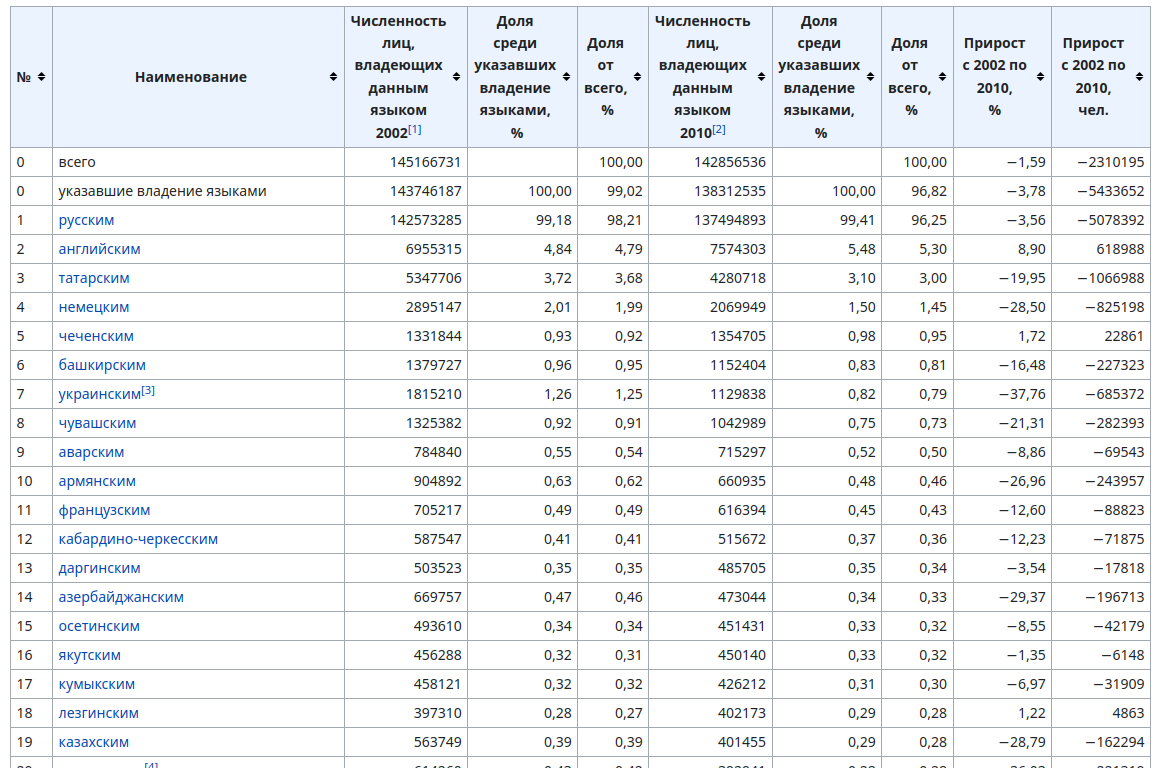
and the list goes on..

..simingly to some absurd point, caused by flukes:
Согласно Всероссийской переписи населения 2002 года, югским языком владело 134 человека, но полевые исследования, проводившиеся в начале 1980-х, показали, что тогда югским языком владело 2 человека, а обследование В. П. Кривоногова в 1992 году выявило, что уже к тому времени носителей языка не осталось[2]. По переписи населения 2010 года, югским языком владел всего 1 человек[1].
Язык был распространён на территории от города Енисейска на юге до села Ворогова на севере. Часть югов проживала в прошлом в верховье Кети (правого притока Оби). В настоящее время сохранилось лишь несколько семей югов в селе Ярцево и селе Ворогово на Енисее, которые родным языком уже не пользуются.
or freaks.. that 1 across a multitude of languages could be caused by a freak demanding переписчицу перечислить все языки, которые он якобы знает. So statistics is a science of large quantities, at individual level it doesn't make any sense. Those were all self-reported. Next time ai speaking all those languages should take the survey. Also many people ignored the перепись, so how many people there are - who knows.
The last in line is Baraba dialect, which is reported to be spoken by only 8 people, while in 1979 there were 8000.
some dialect of tatars now probably reported as pantatar, because
Baraba Tatar is spoken mainly in the Novosibirsk Oblast in Russia. Standard Volga–Ural Tatar is taught at local Tatar schools.
Differences in languages are the immediate root of international animosity:
maltese bla ebda għażla is incredibly root rude in russian.
свой/свои мой/мои рой/рои хуй/хуи
край/края (крой несрагаемый чтоли? (разный крой?))
cбруя/сбруи струя/струи зброя/зброї
ий=он ии=они (in old-russian. christians came to destroy the previous culture, yet they have preserved the language of that stage, and that language did preserve the idea of three mothers in the suffixes and their cases (were there only 3 падежа?) ий им их? иЪ иМ иХ? (х~ш, as ich is read like их in Berlin and like ищ in München (that ch also reminds щ, so soft that h is. and is h~Ь the ь?)
ий окончание прилагательных, и в сущности то же самое он
bely=blon as in blonde?!
bury = brown!!!
back to that red yellow green blue thing, I thought about painting C into yellow, to be more like G, but then I think that yellow is the weak part of the google imagery. But then maybe they have all the geld because of that gelle geelNL
geld is geeled
золото ~ жёлто
z ~ ж (ж is żPO, žCZ and zh)
науськивать (на ушко (ус~ух? на уши усы закидывали? не, скорей всего уста как и уши отверсты как устья))
гласность от слова glass (прозрачность)
И эта этимология прекрасна, даже если мы знаем, что гласность от слова голос. Потому что glass is голос: оно звенит визгом когда разрывапется, и оно музыкально: покалы разрываются от сильного звука на их частоте, а игра на стеклянной арфе (для которой даже русской вики нет в 2022) и позже на стеклянной гармонике (это в россии хотя бы слышали, но не видели (стеклянную афру видели, но знали как называется)) которая
Стеклянная гармоника известна в Европе с середины XVII века. Тогда играли на тридцати-сорока стаканах, прикасаясь к краям которых, исполнитель извлекал такие лёгкие, неземные звуки, будто на землю падают стеклянные шарики. В 1744 году ирландец Ричард Пакрич совершил триумфальное турне по всей Англии с новым, усовершенствованным инструментом, который он назвал «серафим» или «музыкальные стаканчики». Успех был так велик, что уже через пару лет в Лондоне выступил солистом на этом инструменте Кристоф-Виллибальд Глюк. Он исполнил «концерт на двадцати шести стаканчиках, настроенных вешней водой».
The glass harmonica, also known as the glass armonica, glass harmonium, bowl organ, hydrocrystalophone, or simply the armonica or harmonica (derived from ἁρμονία, harmonia, the Greek word for harmony),[1][2] is a type of musical instrument that uses a series of glass bowls or goblets graduated in size to produce musical tones by means of friction (instruments of this type are known as friction idiophones). It was invented in 1761 by Benjamin Franklin.
reading russian wiki we may think that glass harp was invented only three centuries ago. Is it how we taught or is it how we're made think? Is Fomenkoism caused by this conspiracy making our history (the human history) seem short, for subjugation. One who feels himself a representative of a civilization millenias old, he would hold himself higher than somebody who felt his civilization to be one millenium old with little to no information about what happened in the first half of that one millenium.
And only now have I understood the meaning of this image:
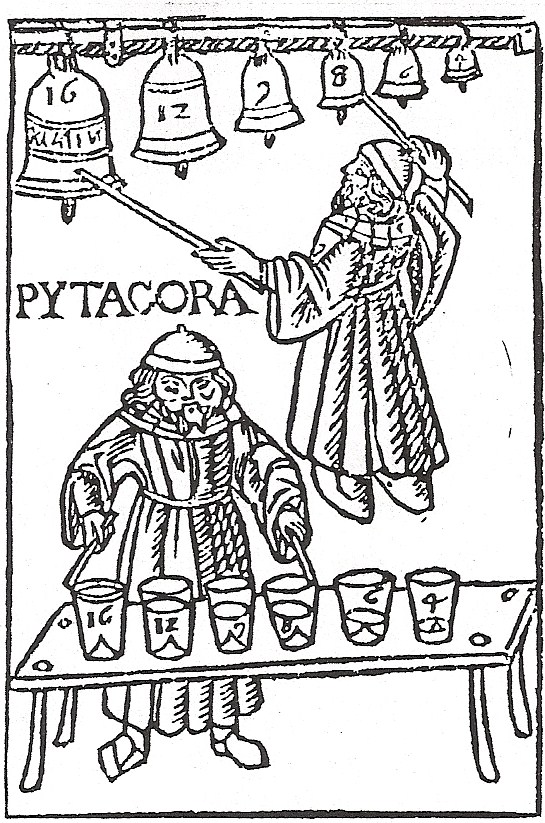
1492 Italian illustration of a person playing a glass harp
only according to the image it's not some person, but Pythagoras himself

what is iv bal, ivbal, iubal, iu bal,
What a wonderful image:gives the story we know (Pythagoras heard harmony in hammers of a forgery and created a musical mode we know as pyhagorean on the basis of that discovery) and also gives numeral information about the system and shows few examples of it and few exacmples of spellings of the name.
He probably was the producer of those hammers, so he knew how much each weighed.
is it something 9-like instead of 10? is it some special symbol for some special number, or is it 9 by some incomprehensible fluke?
According to legend, Pythagoras discovered the foundations of musical tuning by listening to the sounds of four blacksmith's hammers, which produced consonance and dissonance when they were struck simultaneously. According to Nicomachus in his 2nd century CE Enchiridion harmonices [1] Pythagoras noticed that hammer A produced consonance with hammer B when they were struck together, and hammer C produced consonance with hammer A, but hammers B and C produced dissonance with each other. Hammer D produced such perfect consonance with hammer A that they seemed to be "singing" the same note. Pythagoras rushed into the blacksmith shop to discover why, and found that the explanation was in the weight ratios. The hammers weighed 12, 9, 8, and 6 pounds respectively. Hammers A and D were in a ratio of 2:1, which is the ratio of the octave. Hammers B and C weighed 8 and 9 pounds. Their ratios with hammer D were (12:8 = 3:2 = perfect fifth) and (12:9 = 4:3 = perfect fourth). The space between B and C is a ratio of 9:8, which is equal to the musical whole tone, or whole step interval
In Western music theory, a major second (sometimes also called whole tone or a whole step) is a second spanning two semitones (Play (help·info)). A second is a musical interval encompassing two adjacent staff positions (see Interval number for more details). For example, the interval from C to D is a major second, as the note D lies two semitones above C, and the two notes are notated on adjacent staff positions. Diminished, minor and augmented seconds are notated on adjacent staff positions as well, but consist of a different number of semitones (zero, one, and three).
The intervals from the tonic (keynote) in an upward direction to the second, to the third, to the sixth, and to the seventh scale degrees (of a major scale are called major.[2]
The major second is the interval that occurs between the first and second degrees of a major scale, the tonic and the supertonic. On a musical keyboard, a major second is the interval between two keys separated by one key, counting white and black keys alike. On a guitar string, it is the interval separated by two frets. In moveable-do solfège, it is the interval between do and re. It is considered a melodic step, as opposed to larger intervals called skips.
Intervals composed of two semitones, such as the major second and the diminished third, are also called tones, whole tones, or whole steps.[3][4][5][6][7][8] In just intonation, major seconds can occur in at least two different frequency ratios:[9] 9:8 (about 203.9 cents) and 10:9 (about 182.4 cents). The largest (9:8) ones are called major tones or greater tones, the smallest (10:9) are called minor tones or lesser tones. Their size differs by exactly one syntonic comma (81:80, or about 21.5 cents). Some equal temperaments, such as 15-ET and 22-ET, also distinguish between a greater and a lesser tone.
Yule is Ель (это календарь (и ещё один marble to the bowl of oghamic antiquity anticiety antienticity authenthiecy, but then I see that oghamic wheel doesn't have yule, and even if fearn is fir, it's not in the winter) and I found the system of which yule is a part of

Litha is cognate of лето, and I never heard of it.
And I like that this image is rotating this wheel to the right a little, but then it shows me that the wheel is rotating counter-clockwise. And isn't it cause of dismay ot goyim? Should we go to the left? But it takes the left hand. And is left hand lucky? Only in left-handed people. Are goyim taught to be right-handed? I was forced to be right-handed, when I dared to try to use another hand for writing when my right hand got sore.
Western calendar is closer to the astronomic observations, and it could be the reason why they're closer to the core.
We may make an experiment by reforming russian calendar in such a manner than europeans want to follow.
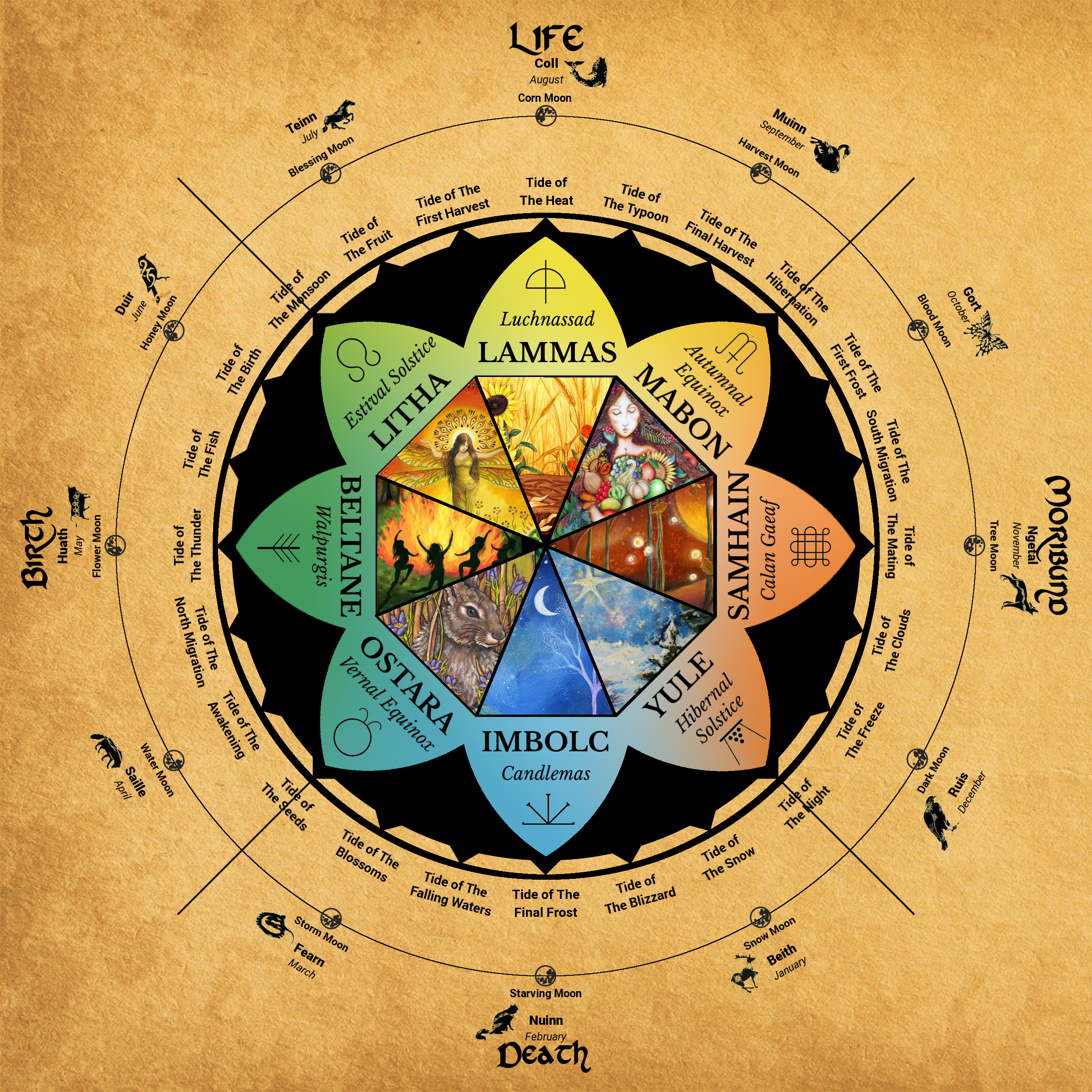
Hollywood is древесина падуба, the yule could be derived from it too: holly is ilex in latin, could be borrowed from the previous name of holly, or it could be some common tradition with cognates.
(this botanic lore is quite a rabbithole, I will explore it in detail, because druidic knowledge is the key, and how could I knever know of holly! it's really incredible, because hollywood is in my face)
The Auraicept is one of the three main sources of the manuscript tradition about Ogham, the others being In Lebor Ogaim and De dúilib feda na forfed. A copy of In Lebor Ogaim immediately precedes the Auraincept in the Book of Ballymote, but instead of the Bríatharogam Con Culainn given in other copies, there follows a variety of other "secret" modes of ogham. The Younger Futhark are also included, as ogam lochlannach "ogham of the Norsemen".
lochlannach is of land of lakes?
eyes are like e in e, bpothe e's look the same direction. is Y nose? then norsk shape ᛸ is more to the point? it is the opening of aicme or oghme tecst, is c cavity, are G and E standing for
R is a plural form of S (are is the plural form of is, were is the plural form of was)
vwls r rdndnt, nd vclssnss (is it why vocal is not english word? s t wh vcl s nt nglsh wrd?) s ls rbtrr, lts hv nl vclss nd snrs.
let's have text with only sonors and voiceless. sonors are protovoiced.
lts hf tkst wt nl snrs nt fslss snrs r prtfst
pkt [pict]? pikts? pictures?
mnl [mongol] менялы? могилы? numbers?
fhs
mnl
pkt
fhs
b d
v z
m(n/l?)
p t
f s
L M N
Lucht (sky in the netherlands, netherlands cloud deutch for me (dutch not deutsch, laat niet duits magelijk dutch
Luft is air in german. And it is a great candidacy to have LMN being elements in deutsch for example.
but alas, no fire for N: licht is fire in the sense of light and it reminds me of lucht, is loch of lake the water, and then it's i o and u for air is behind being discovered later.
i fire (licht)
o water (loch)
в норманских языках ближайшее к lake is lakverf (verf is pier (I know it from russian, верфь is pier)
(there are some semantic differences between верфь и причал (in russian верфь is док, блин, это сложно, грязь, серость, скрой с глаз долой)
Lucht Meer Nigger(there's no N-words for fire, but many words are with V, both are waterlike fricatives, is it the differences? Sonor is more deep, Fire is at the surface. Both V and F are what? They're labials. They're yin/yang/
Beer as the combination of both? or is it Meer pronounced poorly? Either way огненная вода is alcool
Meer
Vuur
Lucht
Land?
Hemel
Hel
does hel become hemel if me is in the middle of it? Some matriarchal belief these words were created in or by.
and the somewhat inversions of one another:
Lucht
Hel
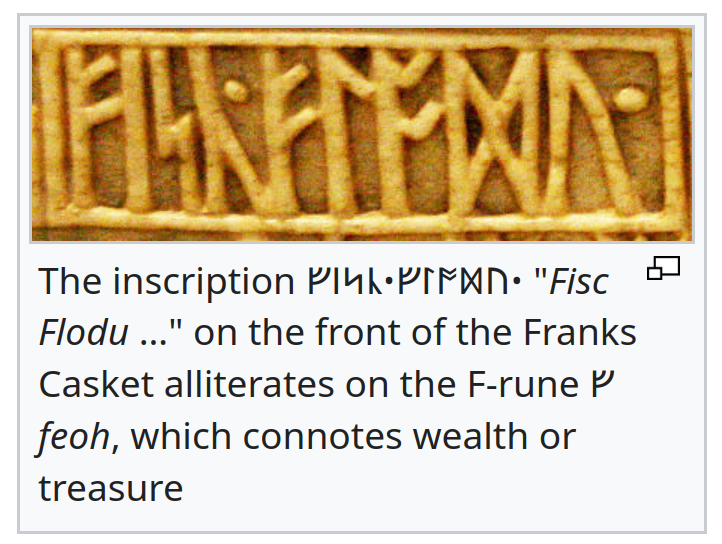
hey, russky, do you know why F is not one of your letters?
f as digamma.. was it replaced not to make BD and FГ system obvious?
is it fishflood? is it fishflow? is it cashflow? if f double c indeed? double h, double ᚢ? w~f (both are vav)
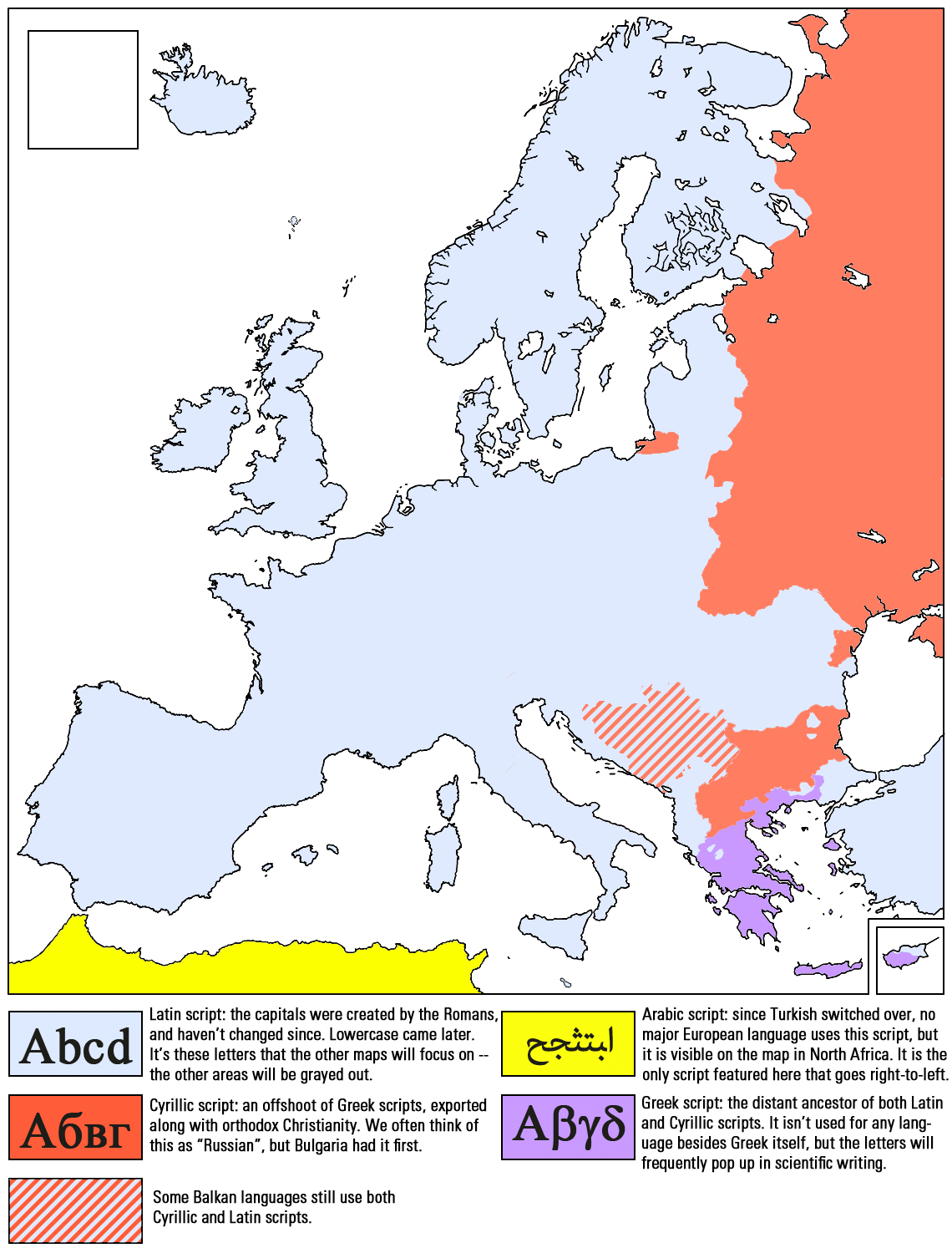
африка абрека
But what is that weird word, ابتثجح, but then it is not more weird than abcd (instead of abc) well, maybe more weird by a couple of simbols, but I suppose they worked out of size, so a line of arabic text is 1.5 times more effective than those alphabets, but on the other hand it's 1.5 times more difficult to read the same ammount of text. Or they only look at dots?
And that uw thing ..oh, it wasn't here, it was in the notebook full of doors, dutch word uw makes me think that uw xyz could
if the v is v or f is not always clear in speech, so my guess is that all letters used to be voiced, and their voiceless variants are only later recognized as special shapes?
A B G D
E V J Z
I M N R
ABGD ~ Abe Бог God, ах боже да
EVJZ ~ явись (в языках отличных от надсат.. and suddenly.. did Burgess expected us to transliterate it as нацат (патамушта пацан, нациками наверное ему казались мы, мы более бесцеремонны, а в совке люди вообще не стеснялись, то ли компенсируя навязываемый с центральных каналов интернационализм (но запрещая культуру многих зарубежных народов, да и внутрирубежных народов подавляя тоже, да, совок это ад, в сравнении с которым этот мир кажется раем) то ли просто будучи неотёсанной деревенщиной городских нарративов не отдупляющей)
I M N.. и меня.. (и мне..) L (love, immanuil (or is it "all"?))
о боже да
явись
имануил
(пел я повторяя это как мантру, это самое чёткое алфавитное чтение)
I M N L is it elements? ts is ц of san as seen in greek and hebrew
о боже да (а ба же та (as in отец и тятя))
е v ж з (ев жизь)
элементс (но элементс не подходят по ритму, потому я пел имануил, пытаяс и остальные под эту форму подбить, но это сырое as it comes, so I don't have to haste it)
but I god distrcted.. that uw thing:
In Europe languages with ⟨w⟩ in native words are in a central-western European zone between Cornwall and Poland: English, German, Low German, Dutch, Frisian, Welsh, Cornish, Breton, Walloon, Polish, Kashubian, Sorbian, Wymysorys, Resian and Scandinavian dialects. German, Polish, Wymysorys and Kashubian use it for the voiced labiodental fricative /v/ (with Polish, related Kashubian and Wymysorys using Ł for /w/, except in conservative and some eastern Polish speech, where Ł still represents the dark L sound.), and Dutch uses it for /ʋ/. Unlike its use in other languages, the letter is used in Welsh and Cornish to represent the vowel /u/ as well as the related approximant consonant /w/.
The following languages historically used ⟨w⟩ for /v/ in native words, but later replaced it by ⟨v⟩: Swedish, Finnish, Czech, Slovak, Latvian, Lithuanian, Estonian, Ukrainian Łatynka and Belarusian Łacinka. It is also used in modern systems of Romanization of Belarusian for the letter ⟨ў⟩, for example in the BGN/PCGN[7] system, in contrast to the letter ⟨ŭ⟩, which is used in the Instruction on transliteration of Belarusian geographical names with letters of Latin script.
Alphabet of Wymysorys brings me contradictory information: wiki tells it goes like UW omittinv V, but omniglot tells me that it includeds S (now are the typos magical? If it is, then they're both correct, but for different historic periods (thus some source is wrong? thus thus)
Polish also does, only this time wiki tells that they use V, and omniglot tells they do not. Wiki explains, that polacks don't use V (and few others) for native words, and mark it grey or in brackets.
But then though it tells that such combination is possible, it's not polish, because too many extra letters. But then all those letters are merely diacritic, so let's fancy their canon without them.. and it aligns into axial only if Y is consonant and it's vowel in polish, so nah, not polish, and I'm retarded to even fancy thought that some alphabet could have carried its authenticity through centuries, or rather millenia. Archaeology might help, but the only way to be certain of it's authenticity is to do the digging personally, and it's not something I'm about to do.
Юты вторглись и поселились в Англии в конце IV века в период Великого переселения народов, как часть более широкой волны германской миграции в Британию[en]. Согласно Беде, они были одной из трёх самых могущественных германских наций, наряду с англами и саксами. Переход в христианство у ютов состоялся в IX веке.
I'm pretty sure they were speaking yuttish
Ascending scale is the most magic, because it takes you from the low state to the higher state of consciousness probably too.
U O A E I
was it naturally on the top of musical theory today, or did thety decide to hide it in the plane sight?
MUsic = MAgic?
MAgic MUsic Mythic
a as number u as note i as letter?
is Y depicting the tridevi of vowel labial lingual?
If we see how it's coming out of the inside, we havwe throat where vocal cords are, tongue in the centre of the mouth, lips at the very exit.
So k s b is a true order, so I have to look for tibetan syllabaries.
The cases of falsifications:
https://is3.livejournal.com/317986.html
https://is3.livejournal.com/317986.html
make me believe that I shouldn't trust archaeology, because money are at play (it would be enough even if ideologies didn't bother, and they do, so we cannot trust the narratives, we can only trust the direct observations. Field research of our own to communicate with the speakers.
Either way, because it gives me excuse to ignore archaeology, so I will only stick to the public data, to the data at least known by millions, and better still the data used by millions.
Sun and moon (son and mom) gave birth to calendars, people probably knew day and night, dusk and dawn at first, and the pictograms of such could be adopted. And then the moon gave them ability to observe months, so sun was about the day, and moon was about the month, thus sun is faster than moon (is it?) so it's naturally to be considered son. And it probably was only millenia later, when people realized the larger cycles and sun began to indicate years (is it why godina is hour in ukrainian? year~hour, very similar words indeed)
is superstition that you shouldn't celebrate it days before it come from calendar being untighed from the sun, and thus church would be the new circle, and thus they demanded people to obey their calendar, even though observations told that their calendar was wrong? Christmas is untighed from the solstice, so that people accept that they celebrate the birth of a jew, not the birth of the year, year is god in russian.
greetings from cognztes.html
god (бог) good, год (рождество вслед за солнцестоянием, разбег вызван неведением того что раз в сто лет нужно пропускать один день, и за сколько бишь веков накопился разбег до 7 января в другом:
The Julian calendar, proposed by Roman consul Julius Caesar in 46 BC, was a reform of the Roman calendar. It took effect on 1 January 45 BC, by edict. It was designed with the aid of Greek mathematicians and astronomers such as Sosigenes of Alexandria.
Григорианский календарь был издан в Риме в 1584 году. Разница между датами юлианского и григорианского календарей увеличивается на трое суток за каждые 400 лет.
Every year that is exactly divisible by four is a leap year, except for years that are exactly divisible by 100, but these centurial years are leap years if they are exactly divisible by 400. For example, the years 1700, 1800, and 1900 are not leap years, but the year 2000 is.
December 21 to 22 are solstices, January 1 or 7 are beginning of the year in grigorian and julian, it sorta disagrees the historic record: russians adopted grigorian calendar in 1918, less than 400 years, yet they were seven days beyond the ..then it goes even weirder: 7th of january is 25th of december, thus they collected exactly two weeks, and it would take them ..well, around 1918 years. So they're truly orthodox, they took dates of Julian Calendar and observed them since the very beginning, but then what made it special is the reform of Caesar. Thus fomenko's claim of an added millenium doesn't stand here
that s in the name of Caesar is read as з in russian, and it makes sense in the light of s standing in the second row in old russian alphabet, and they have з in that line today.
And once again it tells that shapes stand for both voiced and voiceless forms.
As in celtiberian scripts, p/b d/t k/g (and others are probably for borrowed sounds)
Ba Ga Da
Ve Je Ze
Mi Ni Li
Po Qo To
Fu Hu Su
Magic bugic? Basic?
Music Mythic?
Fusic Fysics?
Thinking of flame not casting shadow
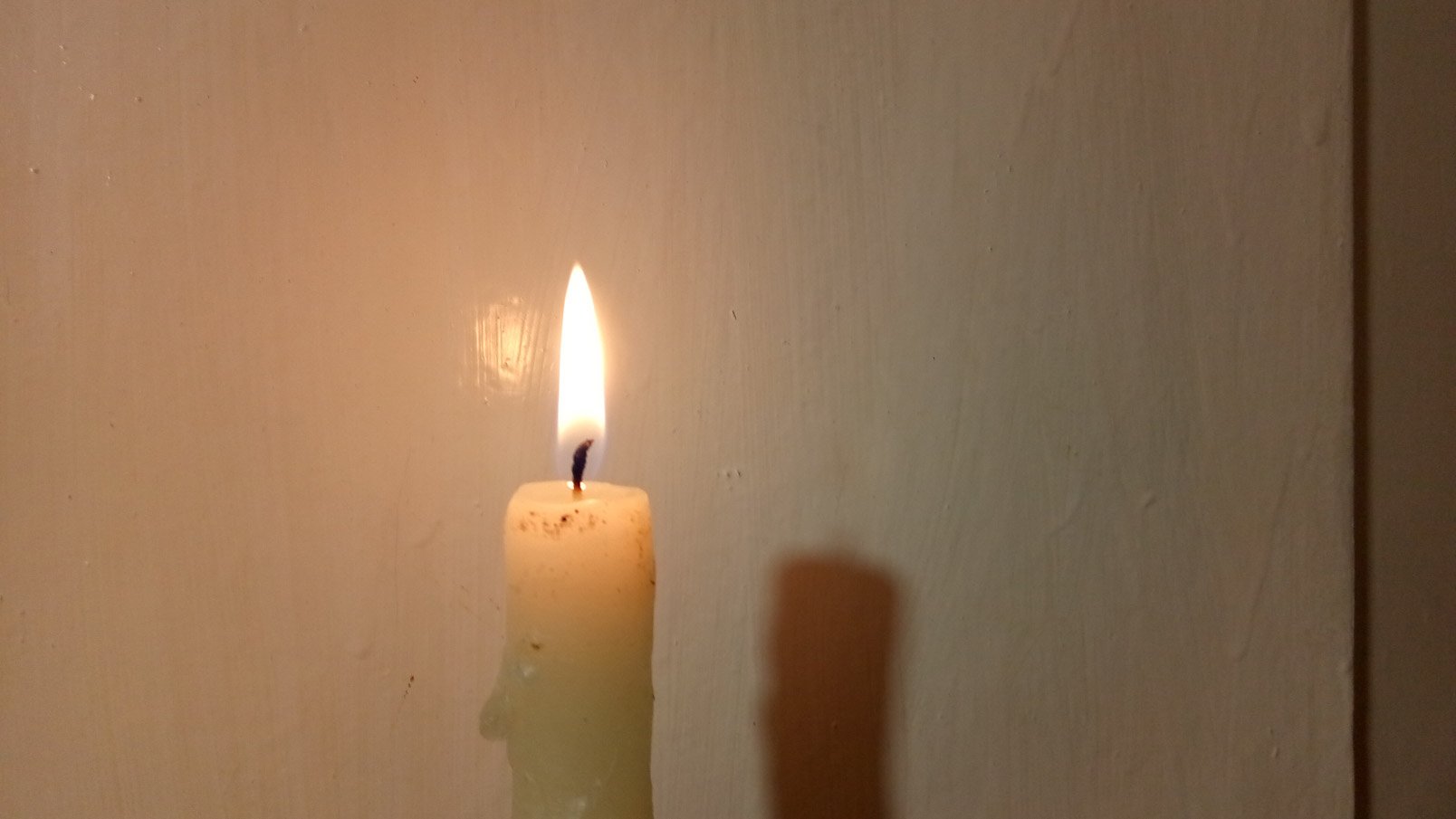
I thought about how it reminds story of vampires, vlam pyres
is metal transmutation actually mental transmutation?
(brought to me by listening to kybalion audiobook (which I dropped half way through) and its mental principle)
Was metal called so, because it took place of the mental element on the scale (as we today conceptualized that fifth element is human or something abstract (but that's luc beson's point of view, but people made it a blockbuster, so whether it was in culture before, it is now. And I think it was in the culture before, why invent somethiong which is better looked up in a book.
But метал is threw, and thinking of throw I though of how much it is through. And threw is even clother to it. Clothe is close, the closest (is -est est?)
> Post the most advanced math theorem you can prove from memory and fully understand.
I am not a mathematician, so it's the Pythagoras theorem
(and no, I would never understand it from how they teach it in school, and because they teach it wrong internationally, I believe that their task is to teach us not to know shit)
Because they're shit, го-о is both говно и государство.
БаБу Бы
It is a memetic sequence, present in a form of an anecdote my father told me, I never heard it elsewhere. And what is even more interesting, is that the other syllabic sequence is also meaningful:
Да, ДуДи
and because гагуги doesn't separate into words, B and D are the basis of the alphabet, , wtf, it is how pdf encoded the ☯ (and google finds it 422 times! it finds ☯ 49300000 times)
Daddy Do (daddy, duh (дуда~деда(dad (deas as in дело труба))))
And also because do~duh~да and бы~be I guess they had the two words, Be and Do, and the third syllably is a grammatic flection:
Маму мы
Маме мы
(мы~me, ма~my, so me and mine as two opposite sides of the story, active and passyve, mommy ~ baby as negroes call their women now, and I guess whites too but only when they speak to children, but then I'm not married, so I'm clueless, they probably call their wives mommy too, as in an ironic way, and here the word irony is wider than dictionaries tell)
Be By
Me My
See Sight(show)
Day Do
but of course I'm only guessing. I should use powers of indifferent ai to pursuit this hypothesis
But then I think why do I force it, why do I demand alphabet to come out of syllabics?
And I thought about ogham, and that there were only 9 signs: three vowels (a e o) and three types of the syllables (yep, still in this concept) actually I didn't think of 9 of them, I only thought that it's interesting how B and M open their sequences, and it made me think that that H used to be F (because that F is out of place, since the writing system is called BLN, not blf,
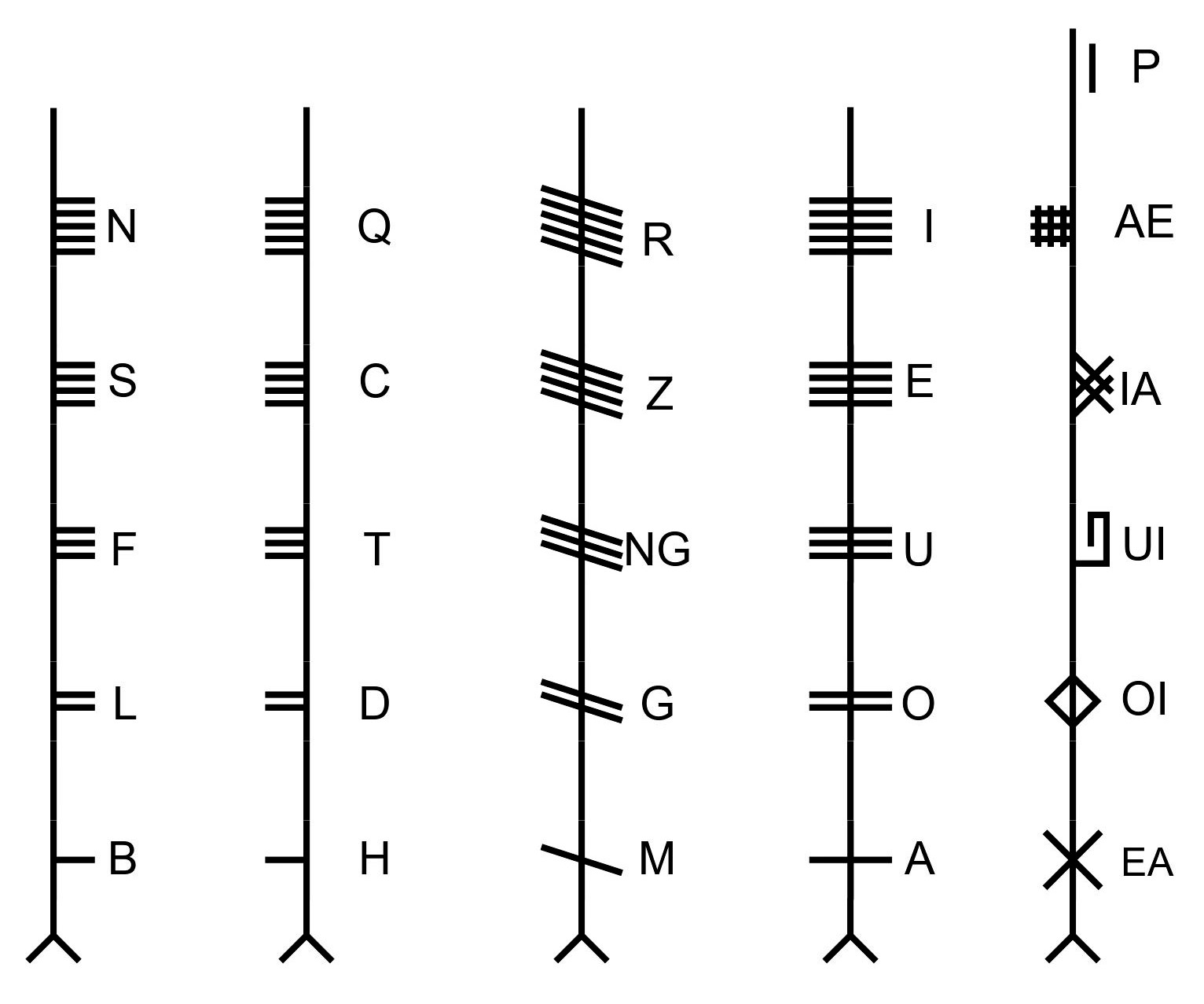
So that made me think of ᚋ looking like double ᚁ or ᚁᚆ and ᛘ at the same time, but then why are those labials still single? does it have something to do with their vowels going the other way around, ou before ei? Either way, are those vowels A for B, E for F(or H) and O for M? because e is the opposite of a in the sense of it looking as it's reflection, and being opposite in it's articulation (A is mouth maximally open, E is mouth open the least, and as Ё it is even Ю) while O is double A, which makes sense in the sense of M, but you know it's all way too raw. Either way, the comparison to alphabet makes me want to rearrange the seconds as D after B, G after H, L after M. But gush I allow myself way too much, the arrogance, but then this arrogance is what allowed me to go this far.
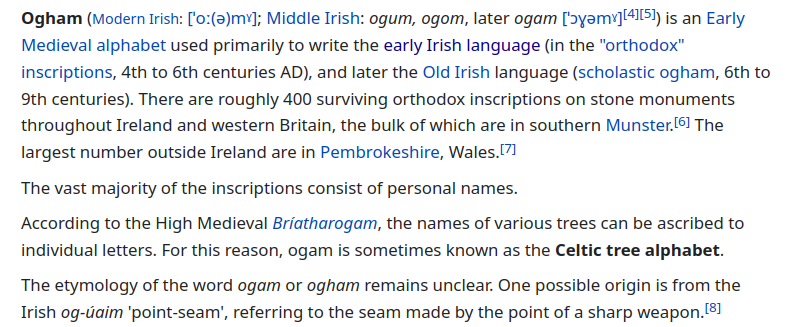
Ogham (Modern Irish: [ˈoː(ə)mˠ]
ˈoː(ə)mˠ
which is incredible in the sense of this:
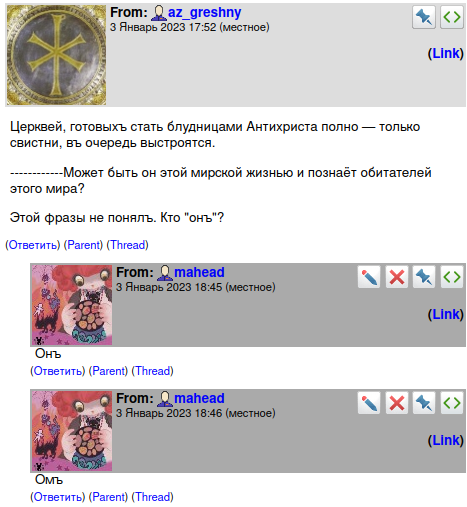
m~n
мы, но нас (в этом свете ом это всё что вокруг, что приставка om- означает в нидерландском, потому что он, они означает "не мы", "около нас")
Another example of j~k: знакомый~знайомий (before it I only knew как~як and качество~якiсть)
Probably, to this paragraph belongs pair искомый~ищем
and if we reflect it onto ukrainian, we see шукати, which naturally begs the question "is шу=ис?"
and the first book on paper I have published is by some cosmic irony published in lubavich printing house (my designer chose them because they publish books for hermitage, and they do publish very well, either way, it is a bright episode in the jq this book touches here and there, I wonder if the isbn will appear in the database in two weeks, but so far I'm rather satisfied, even though they gave it a funky library code, I'm weirdly satisfied with it as well, so when I recognized that word as a hint from a chasidic organization, I told it to my friend who worked with them for some real long time, and he played shock, or was he really shocked, I kinda doubt it, because he looks sorta jewish, and his mother is an accountant, a booker.
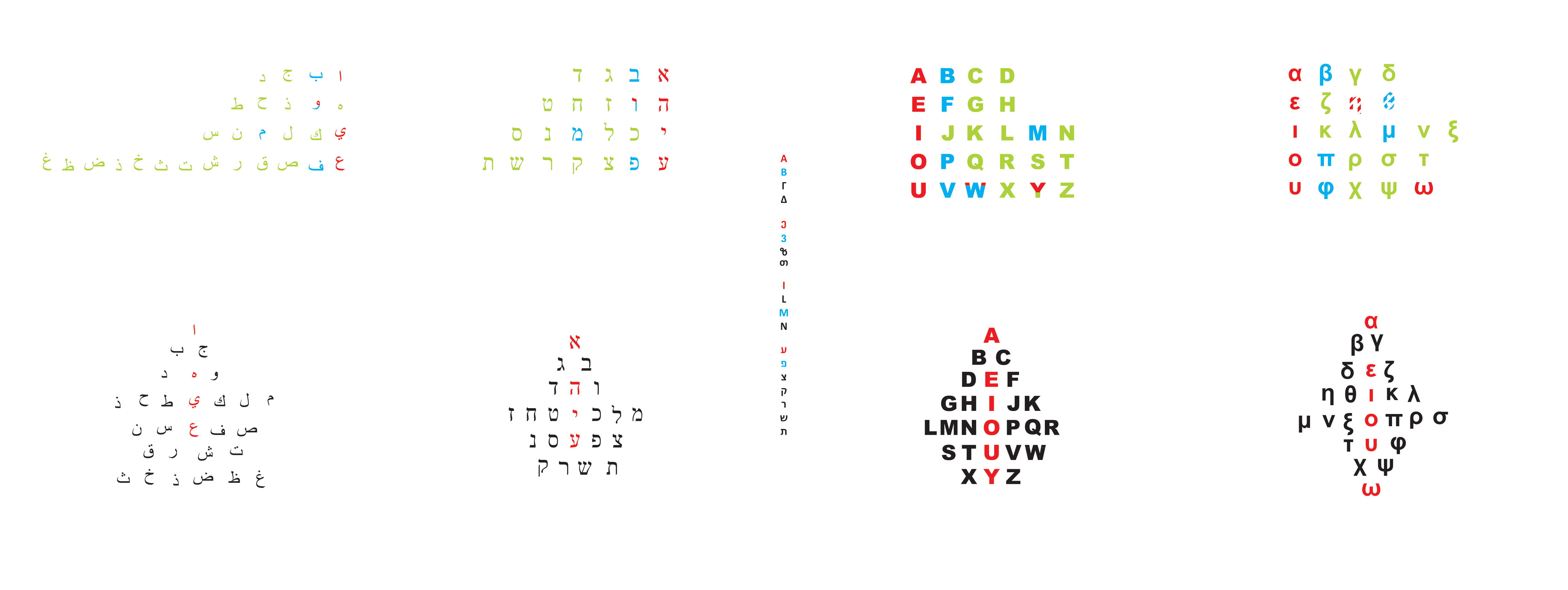
(click it to access an overview with some new elements to it, only it is in russian)
What does Seshat shows me (this image was open for several times in my browser, and I closed it, closed it, and then what would you want to tell me? The staff, the way she holds that reed. I have to watch at that plant, I have to visit Egypt some day, I have to see that plant.
If what she does is ogham (oghm) then what.. we don't know how people who wrote ogham looked, maybe like her. maybe on stick not on stones, and then some "artists" could complicate those staffs so now we hardly see ogham where he is hidden in the plain sight, but maybe not.
What can that image teach us? That there are commas and dots?
claws are the commas, dots are the dots.
Craniosacral knots? Eyes on the colar (open this image in a new tab, it's svg
A little frog can represent the kind of the plant, that it's from a swamp, but papyrus doesn't look like this. So what is this plant?
And it goes on curiouser:
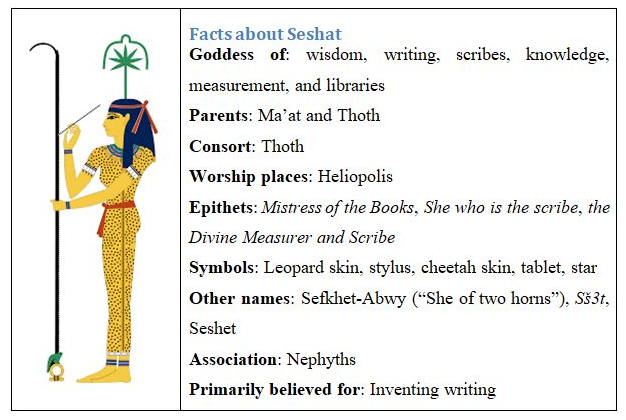
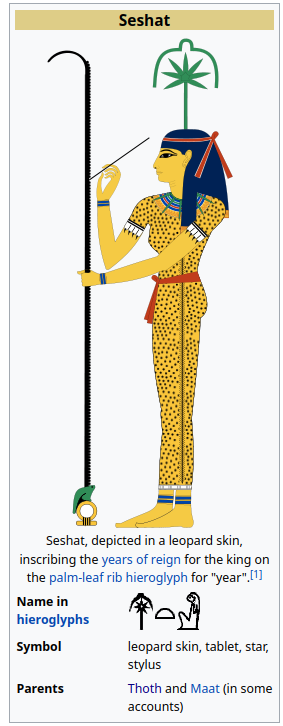
The image to the left tells that Thoth was not just her teacher, but her father! And here I had a false synapse, thinking that Phoroneus was a father to Io, but he was her brother, and thus my attempt to pull Phoroneus to Hermes because of R in the cenre of the names and because of m~n. And F being digamma, which cannot be too far from gamma, and then it fell apart, but then it still brought some parallel between Seshat and Io: And greek name for Thoth is Hermes. And it's where it gets really interesting:
Гера дала задание охранять превращённую в корову возлюбленную Зевса Ио. Зевс поручил своему сыну Гермесу освободить свою любовницу.
which directly synapses to She of two horns from the previous image, and it made me think that Seshat and Io is the same person, and I began to merge them, and I got sIshOt, which synapsed me to russian word счёт (count) and I started thinking.. was math the first magic? of all three the math, myth, mus, it isx the one with a.
How didx they read 𓋆𓈎 as Seshat? did that upper part of the first symbol (the part I suspect to symbolize the cup of semilanceata (but now indded that could be a couple of horns, or is it a prophanic misinterpretation? Because horn signs are upwards: 𓄋𓄌 and the other form of that sesha sign doesn't look like horns at all: 𓋇 and these rabbit ears or whatever it is can be seen in other signs: 𓋁𓋂𓋃𓋄)) stand for C[s] and did that lower part (I consider to be the leaf of cannabis) stand for Ж[ʒ]~Ш[ʃ] or am I only trippin'?
Not so long ago (in this volume actually) I told you about holly and recently (maybe less than a week ago one anon said that hollywood is named after a tree from which magic wands were made)
I think I just recognized B and b to be bow
I was thinking about that magical rainbow, and about how bow the поклон is about bending, and about bow of bow and arrows being bent and then the shape of bows like this made it clear:

And then the sound the тетива bowstring vakes makes reminds B sound a lot.
And it lays perfectly in the context of D the ᚦ standing for axe (and axe does do sound resembling D) and A standing for primitive harpoon have shown before.
And comparing the word rainbow to russian equivalent raduga I can clearly see that duga is bow, and thus ra is rain, Ра~Дажьбог? The way afroasiatic "in" is "b" similar to russian "в"[v] and plural suffix i and some other elements of egyptian languages raises question of who etrurians were, since there are pyramids in Rome, and am I trippin? It is not provent that russians are related to etruscans, common concept is that they're not. I am trippin, let's leave it behind. But who knows, Russians could be related to some tribe from egypt without etrurian connection. My bold guesses are what? They are insane sometimes, maybe, but they're also incredibly accurate sometimes as well. And this raduga~rainbow was given to me by some providence, I wasn't even smoking today, so this story about bows is even more wonderful thus way.
дуга ~ лука? (как в слове излучина)
д ~ л (as детский алфавит told)
And now I smoked all I had left and pervaya ze mysl vyzvavshaya etu knigu: na boga upovayu
na boga? what is boga? boka? side, everything which is aside, not inside, or is inside too? maybe, but all which is different from my personal will. Unless it also gave me that, but then it's unconceivable, which they say it is.
Now I love to write, for I put it down, but also I make it clearer. So I think as I write. And this line is here because I noticed that before I set typing I only knew that бог is on each side of mine (one is good other's bad, but what do we know who is actually who)
Watching at cut out pieces of fish I remember the baltic fair-tale about fish without a tale tail (I think it was a fish with a cut out tail) and the story went like this: some magic was performed and sailors were only allowed to cast their net only twice, in those two times the would be given boatful of fish, but they were not supposed to throw it for the third time. And they did, and only caught a fish without tail, and storm began and it was horrible, and the fish without tail behaved weirdly, so they threw it away and storm ended. What could that be about? My thougth was that the fish without tail guaranteed large catches, as if it was a magic martyr fish, a special fish. Some weirdo cut its tail to see if it still can swimp, and it learned how to swimp without tail, by working with fins more complexly, which could stimulate her mind, which could give it superpowers, and from religious/magic point of view her being the most suffering fish in the pond gave her blessing from gods, so it could get superpowers by this. Or she just behaved weirdly, and was not as fast as other fish, and thus hated that fish and wanted it to be cuaght so it lead it into nets. But then maybe not. Maybe it will, boy, what a raw piece of fish, read the fairy-tale first at least. And why take fairy-tales seriously? Because they're fairy! Either way, too raw.
if b was bow and d was axe, then my guess is taht b was more like D, with the stave inside of the curve, and d would be more like Ϸ with curve being definitely smaller than the stave. But it's only guess, both letters could be come after phases of moon
b could stand for bow and arrows, a could be arrow, that fishing spear could be arrow. Рогатина намекает, что быть может не только рыбные копья такими были, что люди окотились на дичь копьями такими чтоб не убежало в норку помирать, на мелкую дичь сначала охотились, прежде чем на крупную типа оленя пойти рискнули, крупные в нору не убегут, рога помешают.

watching at how abc is the ABT and AMS at the same time, I went further and saw def reminding word deaf (is def records deaf records? or is it death records?) as if they were the additional line for the whisperings, as the ending of that booklet tells, only then they are tef (t et f (t~z? z~s, t~s!)) and the next line also reminds russian глухой (without лу-syllable, but with funny ending of k, which makes it глухийка (что-кто-йка? где-кто? глух as the antonym of слух?) and the lmnopqr doesn't give away such word, and it's as if it represents two other elements: the word element in lmn and the SPQR hidden in OPQR (for σ is a form of ς) and then we have something resembling word stuff, and xyz is as if they stand for хез (хуй его знает, неизвестные, как они и используются сегодня в математике, кто на самом деле может знать сколь древна это традиция..)
if it is in indiant, for example, I like how those four shorties align into a meaningful sentence.
если бы я умел
если б я был умел
the same word is a verb and a short (and they say more basal) adjective
бежал~беглый
смёл~смелый ("кто смел тот и съел" съесть~смести?)
висел~весел(весёлый)? (в смысле висеть, зависать, отвисать, веселиться? или о черепе повешенного? или о шраме от верёвки? на шее уходит вверх? или вешали за рот сначала? чтоб человек пытался перегрызть верёвку и все бы смеялись, блин это правда гораздо жещще, и перекликается с конской упряжью)
чисел.. but it is a noun, ai help me
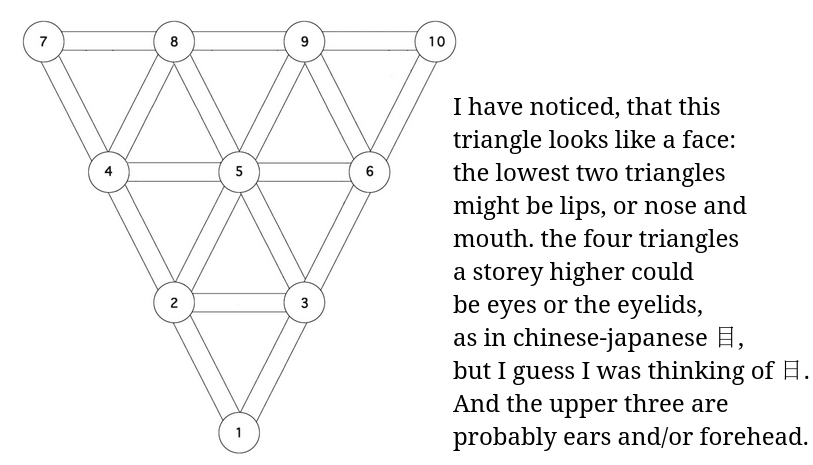
A gift from a friend to the rainbow thing:

and something I found afterwards, it may explain what I saw that day:

Родина значит семья (на украинском)
Hermetic is colde closed, is Hermes an abstract notion? What is Hermes? хер+mes (castration which bible mentions?) her mes (her меч (mes is knife in dutch)) and playing witht homonymy, we may find something which is similar not only by phonetic, but also by semantic components: Herr Magic?
Herr ~ the ~ her? то~той? того? teh is literally тех? The shiortest words are those I have to start with.
сова ~ sofia
hermetic the magic? mathemagic? magic~mathic? mantic! manic? yes, yes. бешен безумен помешан пошаман? mes in помешан то же что и в Гермес? her бес? бес ~ маг? (magic history theory practice tellst that connection with a demon is the quintessence of magic)
mathematician ~ mother magician
(numbers are needed in cooking, which is sorta magical in many aspects)
язык палит подчинённое отношение между народами: холоп это слуга в русском, а в украинском это просто парень (хлопець, хлопчик(холопчик (но холоп в украинском тоже холоп))) boy в принципе означает то же самое (и парень и паж (boy & паж запросто могут быть когнатами))
prodest ~ продаст (продающий, продвигающий, задел у которого (и да, естественно, я здесь лишь гадаю, перебираю, подбираю, отбираю, пробираю))
bright ~ in light? and when I thought of that I didn't think of b being ב(in)
but then why blight is something completely unrelated.
like fry and fly are not related, doesn't it bother me?
well, honestly it does, and it may indicate that orthography is only misleading.
they say blight is of unknown origtin. Is there any chance it's russian блять (болеть)
о-бувь (вокруг 𓃀(б, в))
о-дежда (вокруг 𓂧(д, жд)) or is it o-тело in some language I don't know? Don't forget, guesses
о-ружие ??? ar-m ор-ужие (w-ar) ор сс-ор-а qu-arr-el ар-мия ар-тиллерия г-ар-мати
well, гармати is definitely from related to arms, and army is as well, but are they related to russian ор?
Short words which are neither pronoun nor prefix, let's try on those, in this sence ор is incredible
ор
уд
ил
ел (ел is incredibly awesome because it's root is one letter. Let's find one-letter roots, let's ask the internet about it)
Давай начнём с предлогов и местоимений, состоящих из одной или двух букв
(я загкглирую все, и рассортирую их по частям речи)
Аз Ах Аж Ау Ад Ас Ар Ан Бы Во Го Де Да До Еж Ее Же За Из Ил Кш Ко Ль Мы Ну Но Ни На Об Ох Ор Он Ом По Па Со Се Ум Уж Ша Щи Эй Юс Юз Юг Яр Ям Ял Як Яд
my first find, and it's obviously not complete, I immediately see they omitted то та те ли по etc.
На странице вы можете найти 50 слов содержащих от а до я букв удовлетворяющих запросу - «слово из 2 букв» из известных нам 37620.
oh wow
ОН МЫ ТЕ ТЫ ВЫ ТА блин, гугл мне не поможет, они все тупят: ТО ТУ (и это если не считать тя и -ся)
HE WE IT ME US YE (и здесь тупят: MY найти их (ИХ) простым перечислением было бы проще и точней)
я - местоимение;
в, к, о, с, у - предлог;
и, а - союз;
б - частица (если б, я б в рабочие пошел и т. д.) ;
а, о, э, у - междометие (А! Понял! О! Привет! и т. д. )
У меня получилось 13.
In english there are two: a, I.
but then a, o и у имеют омонимы! т.е. 10 слов? А если я было тоже а, то у а три омонима, и букв всего 9, и с этим уже можно работать:
а б к
и в с
о у э (ещё добавя я (а то так-то о, у, в могут быть одной и той же буквой (особенно о и у (у это среднее между о и в, более древнее и всеобщее))
A (а, я, и)
U(в, о, у)
здесь просится М, но я знаю, что С (я начал с U, затем вставил А (объединив а и и потому что это частицы, которые часто взаимозаменяемы) и теперь вижу, что U это B)
A (а и я)
B (в(во) о(об) у) ~ по~обо
C (к(ко) с(со)) ~ко~до? (c~d?)
э это лишь междометие, потому нахуй, not a word, or everything can be word.
Иногда кажется, что русскому больше латинница подходит, а английскому кириллица: ее=и (смотри в курсиве и поймёшь)
но, с другой стороны, почему тогда оо=u, а не ii~u~y(as ij = y? да, голландскому латинница подходит) я бержу? я гоню, бережу? бередю
as at by in of on to up
by and to are the only biliteral prepositions beginning with consonants!
are other the vowels?
as at E
in I
on of O
up A
The word with may indicate that w predated u (as bornholm's axial suggests)
if up is A, as it may tell to place it upstairs, so isn't down to W?
EIOA ~ EIOwA.. is it её & я?
biliteral is a great term, and because I took it from egyptology, it brought me this:
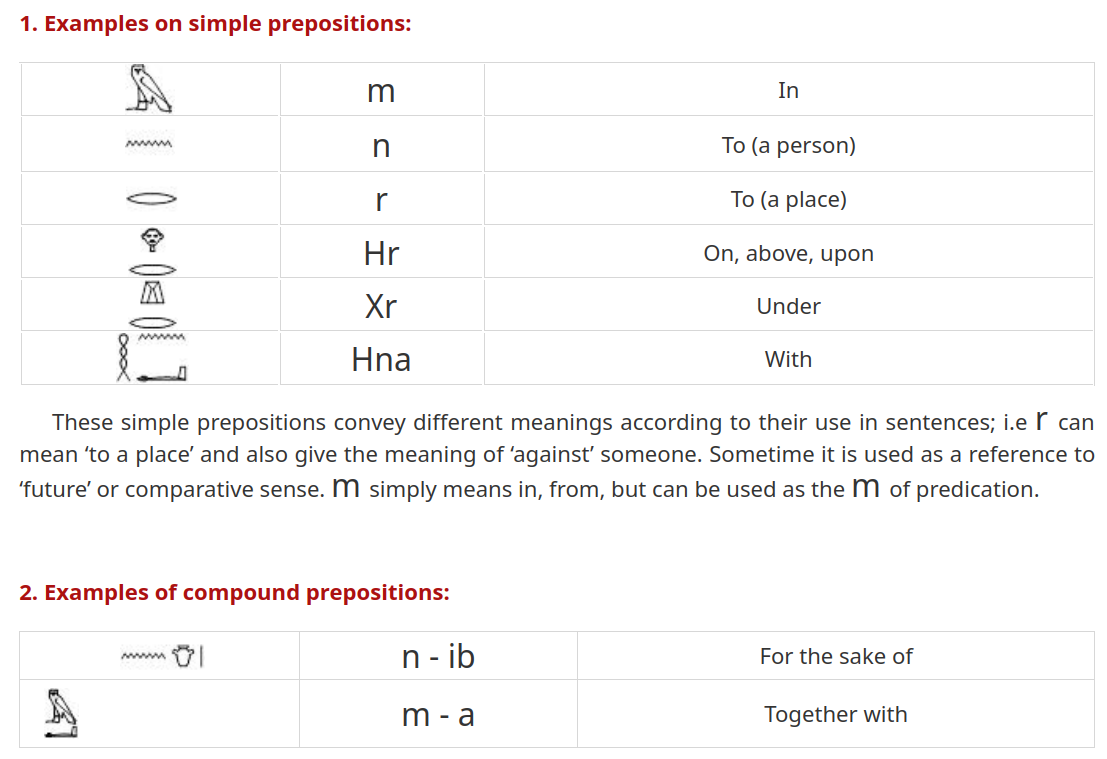
that stroke next to 𓄣 is most definitely a cursor, something to be ignored
Because I'm a freak, I immediately see that 𓁷𓂋 is over and 𓌨𓂋 is under
(which is thoroughly not what egyptologists say those h~ signs are)
and I pull 𓈖 to russian на, and 𓅓 to im~in (and ultimately to ум)
I told you I'm a little freaky. But maybe that's how I memorize the hieroglyphics.

don't forget that some scepsis should persist, because who knows if they read those symbols right, even though it seems to be a really good material, those pictures lead to some good lessons in egyptian
Be Do
Bee Dog
Beef Dogs
Bull Doll
Bull Dog (and I was thinking of first domestic animals, and it is a breed of a dog, a dog dealing with bulls even) Bull is probably of Bu the Moo: Мул is sorta a cognate of Bull (a city dweller cannot tell one from another) But then I recognize that I mess up, because the word I was looking for is Вол.
Мул is something between horse and donkey, and having also labial the initial, it may say that labial column stands for травоядные animals, while Dog and Cat begin with linguals (active, as the opposite of passive)
Для волов меньше, чем для лошадей, затраты на упряжь (из-за мощных шейных мышц, позволяющих серьёзно упростить систему), ковку, уход. Однако скорость воловьих упряжек по сколько-нибудь хорошей дороге заметно меньше конных — идущий шагом человек спокойно обгоняет упряжку (2—3 километра в час).
Ox is english name for the вол, bull is бык, но вопрос остаётся: если вол когната bullа, то is bu=во, and if bull and бык are also somehow cognates, is бы = во? is k~l?

ignore the latter two lines, those semitic examples demonstrate how linguals deviate t~s~ʃ~θ and I know that k is not too far from them, for c is both s and k, so only two consonants existed? b~v~.. not sure about m, because mule is a different kind of animal, or do they both move? did people distinguish between the beasts which could be mounted
big ~ бык
кошка ~ крошка
cat~rat are k and r the opposite, or is it "you're what you eat" thing?
крот~rat? грызуны (но крот ещё ближе к кот, но также и к крыса, от слова грызть)
крот роет, откроет (когда в амбаре пол земляной, то крот откроет его для всей мелкой живности)
рот (rat ~ рот (and also rot (rot also eats goods, жRot)))
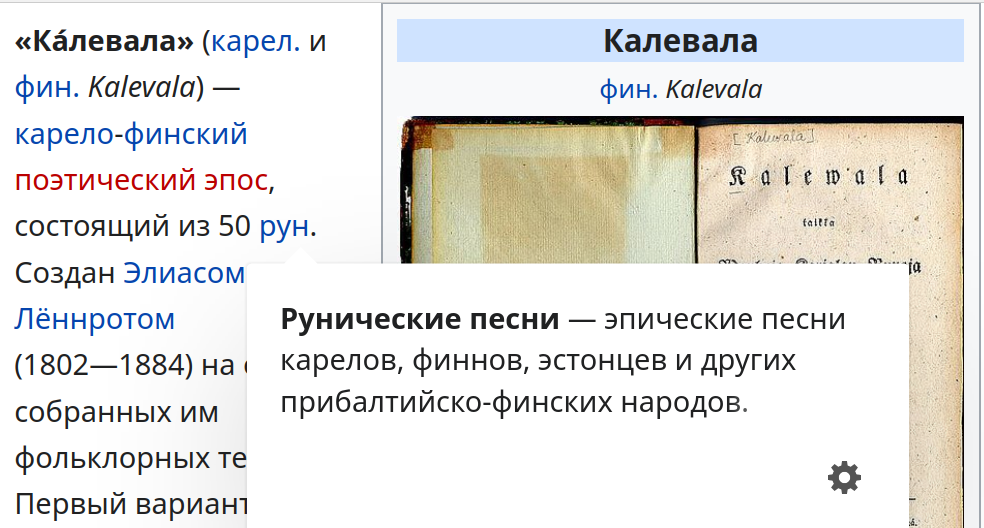
they used word "runes" for "runic songs" and I don't know if I can trust this information, and I dig further, and aye, I can:
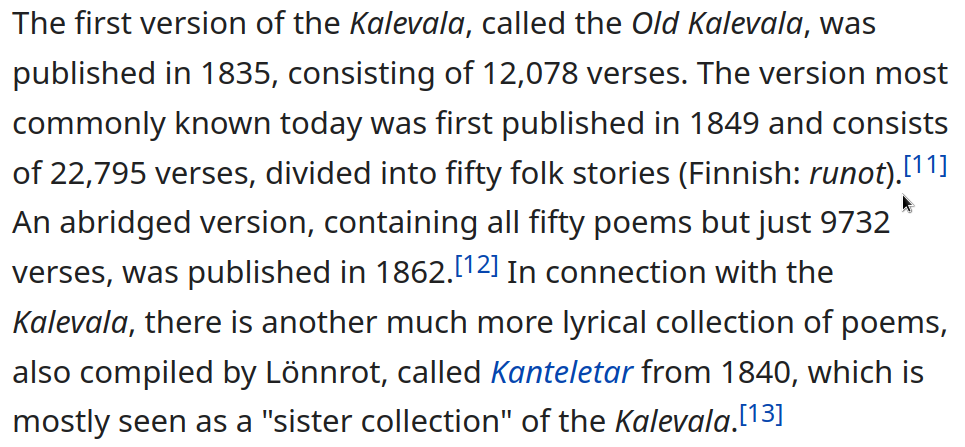
runo is poem in finnish (runot is poems)
rune translated into finnish is loitsu, riimukirjain, taika (and taika is probably of slavic influence, because they say that rune is secret (тайна (taina))
riimu is another word for rune:

and it reminds russian рифма [rifma] and english rhyme
долбоёб ~ довбоєб (украинцы любят букву в, часто русскую г ей заменяют, або here they used it instead of л, which makes me think that V~Г~Λ, or is it Г~Λ~V, типа ГоΛоVа?
але це я рєально довбоєб, бо хохлi часто русскую Λ ей и заменяют, а чтение Г как V це наша обща забава
запад ~ захід (х~п, как в японском, and it makes ход~path cognates)
Но разве одно не от падать, а другое от ходить? Но может и нет, может не от падать.. хм.. хз
IEAOU is the middle ground between AEIOU and IEOUA
And looking for words with that sequence of vowels I only found литератору (dativus of литераторъ)
And I found тору first, just as I found column before I found the other part of Minerva's Column (if this set of words has any meaning is beyond me, and литератору is very japanese, it would be riteratoru перемежая r и t
Column coming first shocked me with its being KLMN-like.
Литература has тура as a part of the word, and I always thought that it's tower, like in tour de bable.. de bible (and bible is babble very much (I'm not saying it was the bible which divided nations, but because bible is translated as book, some book could. Bible is bibbia in italian)
о п r supports the EFГ thing, could it be the thing? is it correct to jump between the writing systems? They're all alphabets, they're all related, I think the national sets are rather arbitrary, or au contraire, established in such manner, that these sequences were not obvious to the plebs. Rude. Rude and silly.
I Λ N M is also along those lines, only M predates N, but then how do we know, check the ΕΖΗΘ thing.
N~Η (russian Н is their N)
i~e is alright, but Λ and Ζ are not compared often, though both are lingual and voiced.
But ABCD doesn't go in any other way, ABGD is as far as it can go, but then АБВГД, but all these keep labial right after vowel.
and why does I Λ N M grow, when EFГ and опr fade? because I Λ N M is ascending, and the other two are descending modes?
Потому как шопот понятен, можем сократить наш детски алфавит:
А Б Г Д
Е В Ж З
И М Н Л
Не думал я сокращать ряд гласных, але забавно, что тако у нас восходящая гамма. о нехай будет а, да и U порой читается как а.
Кажется, что много неразличимых (баба=папа, бабочка=папочка) но по контексту понятно (шёпот ведь понятен) и бабочка теперь как словно папочка листами картонными махает машент.
Но рука как лака и правда непонятна. Детский шёпот? лакА и накА?
Лука́ гораздо понятней, а поскольку пять гласных було с тех стародавних времён, когда всего две согласных було, нехай согласные будут отдельно:
БГД
ВЖЗ
МНЛ
аДам + еВа = Каин? (k is for kill)
(буквам велено было наименовать зверей и вещи?)
Подобно тому, как меня интересовало лишь жрать и ебаться, когда я жил с бабою, адам-охотник может означать еДу, а баба може еБлю означать. (ева=еба, адам=уда например)
I was looking for the source of language of the birds being consisting of all vowels.
In medieval France, the language of the birds (la langue des oiseaux) was a secret language of the Troubadours, connected with the Tarot, allegedly based on puns and symbolism drawn from homophony, e. g. an inn called au lion d'or "the Golden Lion" is allegedly "code" for au lit on dort "in the bed one sleeps" (note that this particular pun cannot be medieval, since final t was pronounced until Middle French, c.f. e.g. the 14th century loanword bonnet).
In Egyptian Arabic, hieroglyphic writing is called "the alphabet of the birds". In Ancient Egyptian itself, the hieroglyphic form of writing was given the name medu-netjer ("words of the gods" or "divine language").
and I didn't find it, but it caught my attention that french word oiseaux contains all five vowels.
I will look for language of gods consisting of only vowels. I did. I found nothing. It doesn't mean I didn't read it somewhere, but then is it being written somewhere prove it to be correct? Now it is written in my book, so?
волк~вовк~wow(типа гав) это пришло из полудрёмы, и подтверждается английской формой wolf ещё больше напоминающей английское же woof.
woof in english and гав in russian remind me of B[read as v in russian] being the first letter in the west, and C[sometimes G] being the first letter in the east. Today it's much more east than russian, but then it could be not so a couple of millenia ago.
What if children are forced into boring schools so that they want to get old sooner so this torture ends, so they are eager to start adult life by fucking early?
Languages do not matter, only words do, so let's collect all the words consisting of vowels from all over the world.
I think it deserves a separated file: I её eau U
This is the power of militanbt autism, I thought to myself, thinking of the way I placed my text in the same sentence with abrahamic religious texts.
krk is czech and slovak word for neck
A B G D
E V J Z
I M N L
O P K T
U F H S (U V X Z can be read exactly as E F H S: V and Z are read as F and S in german, and X is read as H in russian, so the origin could be somewhere between those two white nations)
(O P Q T would be more canonical order, but then I haven't seen it like that either, but I saw ОРСТ in russian (well, almost, exactly if we combine P&R in one graphoneme, for russian R looks like P) and C is read as K, of course. so let's rewrite it:
A B G D [a b g d]
E F Ж З [e v ʒ z] (I have to work on this one, probably latin script is not the best wat to represent it)
O P C T [o p k t]
U V X Z [u f ʃ s] (I decided to use ʃ to reflect actual reading of ж, ɦ is kinda more rare)
(also because X is read as ʃ in portuguese)
I M N L I have forgotten, but what if, just as JK, this line is inserted into this simple 4×4?
the idea of phoneme unification детски алфавит offers доставлает озарениа:
суматошный is шуматошный
Spin clockwise(yang in northern hemisphere/yin in southern hemisphere) or counterclockwise(yin in northernhemisphere/yang in southern hemisphere)(torus spinning). Chant any of these mantras 3 times each while facing east, west, north(in the southern hemisphere), or south(in the northern hemisphere): "im"(like "team"), "am"(like "tom"), "oom"(like "bloom"), "em"(like "them"), and "om"(like "home"). Sleep with your head placed east, west, south(in northern hemisphere), or north(in southern hemisphere).
and here they add the two letters mentioned in sefer yetzirah:
though it's weird that they call them vowels.
and this one I found on the same site, only they don't mention hebrew, they speak of runes:
and I have no idea how authentic it is, but they connect runes with positions of the body
yet they're different positions than the ones given in the one of previous videos, so once again I have to figure it out by myself.
In the morning I didn't open my eyes, нащупал бонг, зажигу, шмалл, дунув спел иеаоу, иеаоу, инвертировал её дабы она стала восходящей, уоаеи, уоаеи, уоаеи, and found the powerful word Why in that sequence. Now I can see, that the opposite of that word must be How, if H is И.
Only three vowels? The initial three: pure vowel A, here looking as H, what? why? labial W, lingual y.
Way is also a very powerful word, and could be also made up of the three mothers.
My as Mij, as Mine, as labial M, vowel I, lingual J, and thus does Y combine vowel and lingual? well, yea, it's actually the two functions it is playing, and in russian у is even labial vowel, thus the three branches of Y, even if we recognize the older one as stem the stave, then it's dual, as we can see in ij, but what if those are three equal parts? what if it is not a tree?
not only water in french is all vowels, but also air in english (written like air, read like ea)
выя = шея (выть от этого слова? а вытянуть?)
лгладить у у к ладми д д ладить
I'm 25% ukrainian, and it shows in the shape of my boldness (baldness is the word, but boldness as well) which leaves the хохол (чуб) whichi is both russian somewhat slightly deragatory word for ukrainian and also a synonym for чуб (forelock)
I'm not sure about the term I use, so I attach the picture to tell that I'm speaking of the hair at the front part of the hair, often traditionally worn by ukrainians as a national hairdo, and thus it naturally could be the etymology of that funny (not really deragatory, because I use it like I use nigga, with no animosity)

And I also brioiught it here (brought (берёт (скорее мнемоническое чем этимологическое замечание, отправлено в cognates.html))) because it caught my attention that peot grow on the part called temple (and that not all side is temple, but only that specific part)
Is crown supposed to be worn on that part of the head called crown? was it held by a cord first?
And some crowns do have the ribbons, and exactly two ribbons they have:
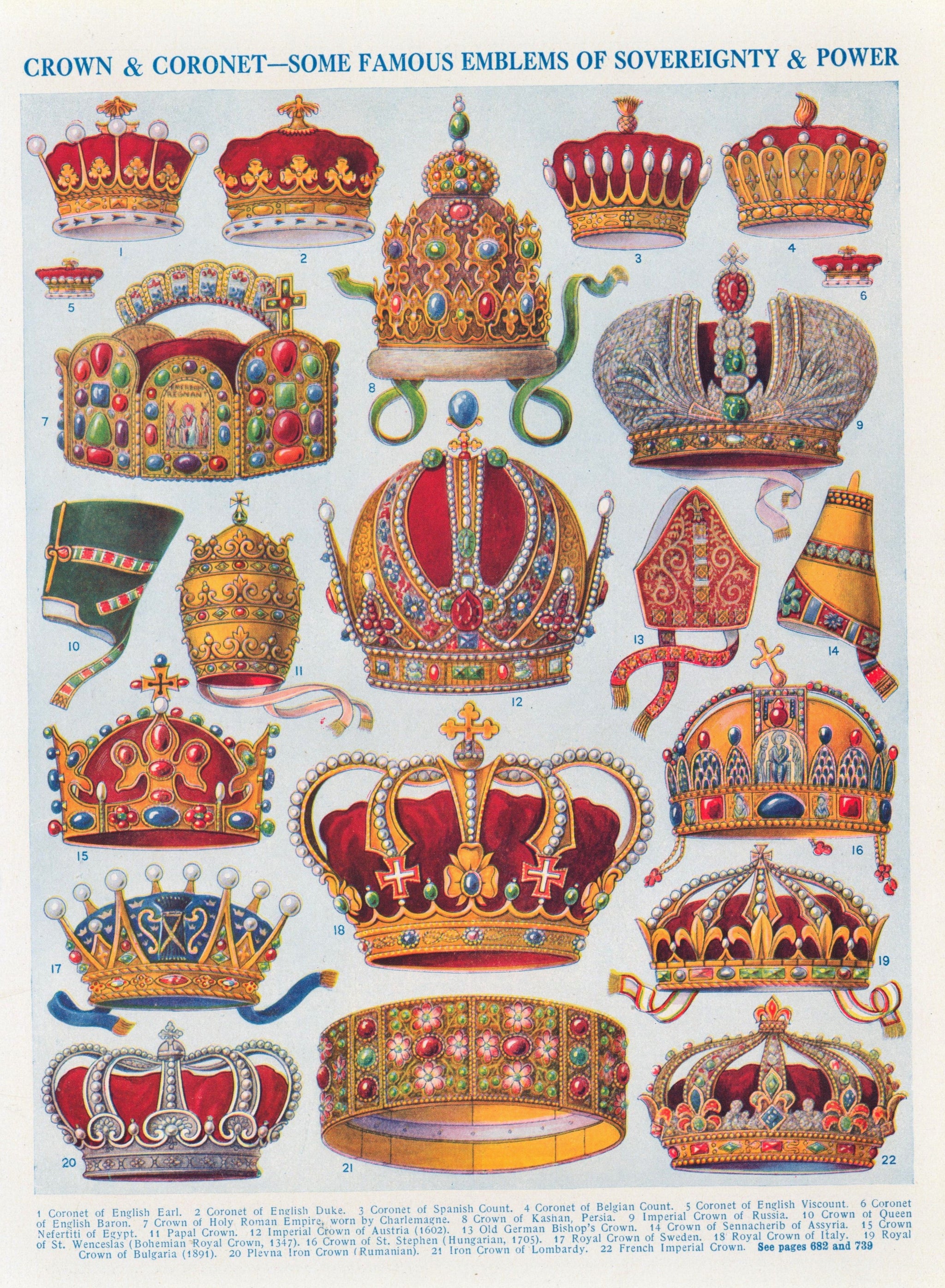
not sure about the crown of nefertiti though, other depictions don't show that ribbon, and royal crown of sweden also doesn't show them on other images (are they there in principle, but usually are hidden inside? Но папская тиара действительно имеет ленты, только они не завязываются, а спускаются вдоль тела. Завязываются они во время какого-нибудь тайного ритуала? Как знать.. Но надо попробывать (начав с конического колпака, поэкспериментировать с материалами, но лучше сначала теории навернуть, наверняка где-то об этом труды существуют.)
brought (br as proto-P? (p is p in latin, but R in greek))
caught
thought
fought
got?
hot?
naught?
aught (something)
nought (nothing)
ought (nothing, owe (probably from this word (and the word so vowel it could be protovowel) )
How on earth do they distinguish between aught and ought!
Или это подобно русскому "ничего не знаешь про этого человека?" = "знаешь ли чего-нибудь о нём?" (да, скорей всего так и есть, и гугл-транслейтор обманчиво подосвывающий "ничего" вместо "нечто" для aught, быть может знает что делает, потому что в этом контексте причина и сходства слов нечто и ничто)
is waught ~ what?
English is not my native language. So why must I work in it, I will always do the second-rate job in comparison with someone brittish I have shown the way, and it is enough, let's focus on russian from now on.
Гласных английских слов вроде больше, owe, awe, and so on (unless w is consonant)
в русском всего ничего, вроде бы.. однобуквенных всяко больше: а, и, о, у (but, and, about, at) and suddenly, the way most of them start with a (and the other is with be, interesting too, and that 'cause is with c, could be the indicators of beginning of the alphabet being the place for the most fundamental words, and as runes and ogham go from bottom up, it made even more sense since all the alphabet seems to be based upon those abc))
и а о у
and but of on? at?
её (ей?)
я
а я её? и я её? я у её?
я её!
ересь ~ RS? (the false reading of P?)
err ~ R as the wrong reading of P?
wrong is -ing form of the same R, isn't it? of the same rho?
but then I think... right also begins with R.. is it some other R? some pr as in право?
pright? pride?
bright (ярко, не скрытно)
bright ~ pride
Then what is blight? глядя на изображения, мне приходит на ум слово покраснение
is light~red?
poetry is also /po/
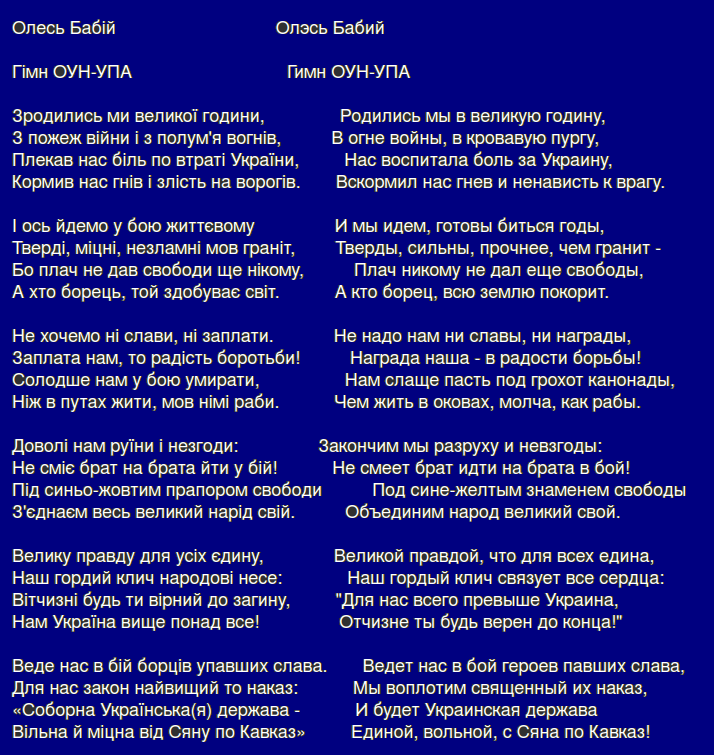
Why does that ferocious translator Nesterenko translate мiцна as единой, if it's мощной. Is he working for единая россия, подсовывая её конструкции (слова) вместо украинскихъ! Russian language die! This is what he's making with his magic. Good, godd,
So I don't even mind, let it become obsolete as latin, a historic language, dead language along with hebrew and latin (hebrew is a resurrected language) re-sur-rect-ed (rect as in erect, to right, поставить, to make right, upright, right as in right angle)


straight as the opposite of right (I was expecting "left" at that angle) straight ~ sinister?
dexter ~ right
is such shuffle possible?
re- ~ -er?
de- ~ -ed?
Richter (r~d)
opqr~abcd
(s appeared when a did? opqr dictates a, unless it's ba ka ta)
ba ga da ~ b c d [b g d]
be ge de ~ f ж з [v ʒ z]
bi gi di ~ m n l [m n l]
bo go do ~ p q t [p k t]
bu gu du ~ f h s [f h s]
How did z become h? z is g! z is ж, z is ž
f g h [v ʒ z]? H~ (и~с[zUA] and it tells me that abc is what there is:
abc [ba za] база (губной упругий, язычный долгий) ba da
efg [ve ʒe] вези (дВИЖЕние)
imn [me ne] меня (мене (мне))
opt [po tom] опыт
ufs [fi si] physic? (but if оп-ыт, то of-us)
аб аз (обоз)
ев ез (и вес? эфес? of us!)
a b c (a b g (a b d))
russian word азбука has k of c, not г, not д, abc [абк(abacus, абак (счёты))]
аб ак (гласная стоит в начале строки, потому что закрытый слог)
ев ес ??? если счёты, то должно быть что-то подобное, но эфес лишь периодом подобно
Ephesus (/ˈɛfɪsəs, ˈɛfəsəs/;[1][2] Greek: Ἔφεσος, translit. Éphesos; лат. Ephesus; Turkish: Efes; may ultimately derive from Hittite: 𒀀𒉺𒊭, romanized: Apaša) was a city in ancient Greece[3][4] on the coast of Ionia, 3 kilometres (1.9 mi) southwest of present-day Selçuk in İzmir Province, Turkey. It was built in the 10th century BC on the site of Apasa, the former Arzawan capital, [5][6] by Attic and Ionian Greek colonists. During the Classical Greek era, it was one of twelve cities that were members of the Ionian League. The city came under the control of the Roman Republic in 129 BC.
The city was famous in its day for the nearby Temple of Artemis (completed around 550 BC), which has been designated one of the Seven Wonders of the Ancient World.[7] Its many monumental buildings included the Library of Celsus and a theatre capable of holding 24,000 spectators.[8]
if left is le-foot, then right is ri-ghoot? L and гr, leg, leg as LГ?
Г ~ g ~ d of dexter? isn't it pulling owl onto globe?
обоз
эфес
оман
Oman is the site of pre-historic human habitation, stretching back over 100,000 years
Значин не обоз, а ..and my mind rushes to abacus
The word abacus dates to at least AD 1387 when a Middle English work borrowed the word from Latin that described a sandboard abacus. The Latin word is derived from ancient Greek ἄβαξ (abax) which means something without a base, and colloquially, any piece of rectangular material.[2][3][4] Alternatively, without reference to ancient texts on etymology, it has been suggested that it means "a square tablet strewn with dust",[5] or "drawing-board covered with dust (for the use of mathematics)"[6] (the exact shape of the Latin perhaps reflects the genitive form of the Greek word, ἄβακoς (abakos)). While the table strewn with dust definition is popular, some argue evidence is insufficient for that conclusion.[7][nb 1] Greek ἄβαξ probably borrowed from a Northwest Semitic language like Phoenician, evidenced by a cognate with the Hebrew word ʾābāq (אבק), or “dust” (in the post-Biblical sense "sand used as a writing surface").[8]
they definitely pulled the definition to hebrew for political reasons, it's as far as could be, and neither can have any archaeologic evidence, nor does it make any sense as a tool of count if you really think of that.
The shape of the abacus and the structure of the alphabet I have discovered here make perfectly clear that the name is from the system which was used to make the syllables of two consonants the B T and the five vowels, the aeiou, or whatevwer this sequence was: aiueo, aouei, etc.

Those double beeds make three positions: let's guess that this initial is a (pure vowel, none of the two) and when the beads are at the different side of the stave(!) they're B and when the two are at the other side, it's d, and that would explain why a and d are alike.
And the five beeds are probably in the basic position, a position of a
then e is the first deviation, and i is two beads, the ee, and then what else do we have if not to follow the alphabetic order of three beads standing for o, and four for u. and what would all the five at the other side of the rod say? closed syllable. pure consonant. shwa, no vowel. Or would such position of the v0owel beads say that the board is not in use? And to my pleasure (which pleases) I can see the trace of the handly denoting the position in which the abacus was carried around, and that supports my guess. If it's of a handle. And even if, then only maybe. Pure guess, bold guess, but the 2+5 set is legendary.
But until a legend of using abacus for transmission of text appears, all this is not more than fantasy.
The abacus, also called a counting frame, is a calculating tool that was in use centuries before the adoption of the written modern numeral system and is still widely used by merchants, traders and clerks in Asia, Africa, and elsewhere. It can be used for high-speed addition, subtraction, multiplication, division, square roots, cube roots and other calculations. Some devices can be quite large and complex. Now this ‘ancient computer’ has received credit for its historical and cultural importance by being added to the world intangible cultural heritage list .
The typical abacus has a hardwood frame and hardwood beads, with two decks and more than seven rods. The upper deck, which is known as heaven, has two beads on each rod. Each bead has the value of five. There are five beads on each rod on the bottom deck, known as earth. Each has the value of one. The beads are moved up and down during calculations.
So, as I theorized, vowels are not air, but earth! And if heaven is BT, as I thought, then it supports my claim that shamaim = ash+maim.
if shamaim is cognate of heaven, it shows how h comes ʃ
Today, it contributes to the advancement of calculating techniques, cognitive schemas, educational psychology and intellectual development. It also has a far-reaching influence in various fields of cultural creativity, including folk customs, language, literature, sculpture and architecture.
They said "language" (speaking of abacus) and that is all I could find so far. I think if it's there, it will come my way. Until then it just hangs here amongst naked hypotheses, interwoven with some previous conceptualizations, should be taken with causion though.
magic~mystic~music
mystic is of myth! that y tells it.
st~f? satan~fan? friend? (but satan is literally enemy (cd as the opposite of fr? see, such variability makes the system non-existent, so I should stick to the separation of linguals and labials, to build a mnemonic narrative of languages by that system I would then not discover, but ))
тяг(а) тяни
ляг(ай) лени(сь)
(за)пряг(ай) прыгай? пряжей? пращей? плетью? плащом? плечом? врачом грачом неочём
ч в врач то же что и в что? -que the que?
grotesque (somewhat of grotes) ?
bourlesque (somewhat of ball brawl bubble) ?
arabesque (somewhat of arabs)
churrigueresque microtechnique sculpturesque unpicturesque cinematheque picturesque discotheque gigantesque plateresque communique radiopaque statuesque picaresque catafalque humoresque semiopaque antiplaque technique grotesque burlesque arabesque monocoque odalisque plastique equivoque dominique nonunique chibouque critique boutique mystique physique applique pratique remarque postique biunique barbeque moresque antique baroque oblique brusque macaque cacique bezique perique relique silique lalique cazique piroque unique torque plaque cheque opaque mosque basque clique cirque masque marque cinque risque bisque barque manque claque casque pulque calque caique sacque cloque ubique bosque pique roque toque tuque usque fique
but in french it's way more common:
ABANDONNIQUE ABAQUE ABDIQUE ABIOTIQUE ABLOQUE ABOULIQUE ACADEMIQUE ACALORIQUE ACATALECTIQUE ACATALEPTIQUE ACATHISIQUE ACETIQUE ACETONEMIQUE ACETYLENIQUE ACHROMATIQUE ACHROMATOPSIQUE ACHROMIQUE ACHRONIQUE ACIDIMETRIQUE ACIDOBASIQUE ACINETIQUE ACLINIQUE ACNEIQUE ACOUMETRIQUE ACOUSMATIQUE ACOUSTIQUE ACROBATIQUE ACROMEGALIQUE ACROSOMIQUE ACRYLIQUE ACTINIQUE ACTINOMETRIQUE ACYCLIQUE ADAMIQUE ADIABATIQUE ADIPIQUE ADRENERGIQUE ADRENOLYTIQUE ADRIATIQUE ADYNAMIQUE AERAULIQUE AEROBIOLOGIQUE AEROBIQUE AERODYNAMIQUE AEROLOGIQUE AERONAUTIQUE AEROSTATIQUE AEROTECHNIQUE AEROTHERMIQUE AGENESIQUE AGNATIQUE AGNOSIQUE AGNOSTIQUE AGOGIQUE AGONIQUE AGONISTIQUE AGRAMMATIQUE AGRAPHIQUE AGROBIOLOGIQUE AGROCHIMIQUE AGROECOLOGIQUE AGROLOGIQUE AGRONOMIQUE AGUEUSIQUE AKATHISIQUE AKINETIQUE ALAMBIQUE ALBRAQUE ALBUMINURIQUE ALCAIQUE ALCALIMETRIQUE ALCHIMIQUE ALCOOLIQUE ALDEHYDIQUE ALEMANIQUE ALETHIQUE ALEXIQUE ALGEBRIQUE ALGINIQUE ALGIQUE ALGOLOGIQUE ALGORITHMIQUE ALICYCLIQUE ALIOTIQUE ALIPHATIQUE ALLEGORIQUE ALLELIQUE ALLERGENIQUE ALLERGIQUE ALLERGOLOGIQUE ALLOMETRIQUE ALLOPATHIQUE ALLOPATRIQUE ALLOSTERIQUE ALLOTROPIQUE ALLYLIQUE ALOETIQUE ALOGIQUE ALOPECIQUE ALPHABETIQUE ALPHANUMERIQUE ALTAIQUE ALTIMETRIQUE AMAGNETIQUE AMAUROTIQUE AMBIOPHONIQUE AMBLYRHYNQUE AMBROSIAQUE AMERLOQUE AMETALLIQUE AMHARIQUE AMIMIQUE AMMONIAQUE AMMONIOTELIQUE AMNESIQUE AMNIOTIQUE AMPELOGRAPHIQUE AMPHETAMINIQUE AMPHIBOLIQUE AMPHIBOLOGIQUE AMPHIBRAQUE AMPHICTYONIQUE AMPHIGOURIQUE AMYLIQUE AMYOTROPHIQUE ANABOLIQUE ANACHORETIQUE ANACHRONIQUE ANACLITIQUE ANACREONTIQUE ANACYCLIQUE ANAGLYPTIQUE ANAGOGIQUE ANAGRAMMATIQUE ANALEPTIQUE ANALGESIQUE ANALLERGIQUE ANALOGIQUE ANALYTIQUE ANAMNESTIQUE ANAPESTIQUE ANAPHORIQUE ANAPHRODISIAQUE ANAPHYLACTIQUE ANAPLASIQUE ANARCHIQUE ANASARQUE ANASTATIQUE ANASTIGMATIQUE ANASTOMOTIQUE ANATOMIQUE ANDESITIQUE ANDROGENETIQUE ANDROGENIQUE ANDROLOGIQUE ANECDOTIQUE ANECHOIQUE ANELASTIQUE ANEMIQUE ANEMOMETRIQUE ANERGIQUE ANESTHESIQUE ANESTHETIQUE ANGELIQUE ANGIOGRAPHIQUE ANGIONEUROTIQUE ANHARMONIQUE ANHIDROTIQUE ANHISTORIQUE ANHYPOTHETIQUE ANIDROTIQUE ANIMATIQUE ANIMATRONIQUE ANIONIQUE ANODIQUE ANOMALISTIQUE ANOMIQUE ANOREXIQUE ANORGANIQUE ANORGASMIQUE ANOSMIQUE ANOXEMIQUE ANOXIQUE ANTAGONIQUE ANTALGIQUE ANTARCTIQUE ANTEISLAMIQUE ANTHELMINTHIQUE ANTHOLOGIQUE ANTHRISQUE ANTHROPIQUE ANTHROPOLOGIQUE ANTHROPOZOIQUE ANTIACNEIQUE ANTIALCOOLIQUE ANTIALLERGIQUE ANTIANEMIQUE ANTIARYTHMIQUE ANTIASTHMATIQUE ANTIATOMIQUE ANTIBIOTIQUE ANTICALCIQUE ANTICYCLIQUE ANTICYCLONIQUE ANTIDIABETIQUE ANTIDIARRHEIQUE ANTIDIPHTERIQUE ANTIDIURETIQUE ANTIECONOMIQUE ANTIEMETIQUE ANTIEPILEPTIQUE ANTIETATIQUE ANTIFONGIQUE ANTIGENIQUE ANTIHYGIENIQUE ANTILITHIQUE ANTIMACONNIQUE ANTIMALARIQUE ANTIMITOTIQUE ANTIMONARCHIQUE ANTIMONIQUE ANTIMOUSTIQUE ANTIMYCOSIQUE ANTIMYCOTIQUE ANTINAUPATHIQUE ANTINEVRALGIQUE ANTINOMIQUE ANTIPALUDIQUE ANTIPANIQUE ANTIPATHIQUE ANTIPATRIOTIQUE ANTIPOETIQUE ANTIPSORIQUE ANTIPSYCHOTIQUE ANTIPYRETIQUE ANTIQUE ANTIRABIQUE ANTIRACHITIQUE ANTISCORBUTIQUE ANTISEPTIQUE ANTISISMIQUE ANTISOVIETIQUE ANTISPASMODIQUE ANTISTATIQUE ANTISYMETRIQUE ANTITETANIQUE ANTITHERMIQUE ANTITHETIQUE ANTITOXIQUE ANTIVARIOLIQUE ANTONYMIQUE ANURIQUE ANXIOLYTIQUE AORTIQUE APAGOGIQUE APATHIQUE APERIODIQUE APHASIQUE APHORISTIQUE APHRODISIAQUE APIQUE APLANETIQUE APLASIQUE APNEIQUE APOCALYPTIQUE APODICTIQUE APOLITIQUE APOLOGETIQUE APOLOGIQUE APONEVROTIQUE APOPHANTIQUE APOPHATIQUE APOPLECTIQUE APOPTOTIQUE APORETIQUE APOSTOLIQUE APOTHEQUE APOTROPAIQUE APPLIQUE APRAGMATIQUE APRAXIQUE APRIORIQUE APRIORITIQUE APYRETIQUE AQUATIQUE ARABESQUE ARABIQUE ARCHAIQUE ARCHANGELIQUE ARCHEOLOGIQUE ARCHEOZOIQUE ARCHETYPIQUE ARCHEVEQUE ARCHITECTONIQUE ARCHIVISTIQUE ARCTIQUE AREIQUE AREOMETRIQUE ARGENTIQUE ARGOTIQUE ARISTARQUE ARISTOCRATIQUE ARISTOPHANESQUE ARISTOTELIQUE ARITHMETIQUE ARNAQUE AROMATIQUE ARQUE ARRHENOTOQUE ARSENIQUE ARTERITIQUE ARTHRALGIQUE ARTHRITIQUE ARTHROSIQUE ARTISTIQUE ARTOTHEQUE ARYTHMIQUE ASCETIQUE ASCITIQUE ASCORBIQUE ASEISMIQUE ASEMANTIQUE ASEPTIQUE ASIARQUE ASIATIQUE ASISMIQUE ASPARTIQUE ASPHALTIQUE ASPHERIQUE ASPHYXIQUE ASQUE ASSERTORIQUE ASTATIQUE ASTERISQUE ASTHENIQUE ASTHMATIQUE ASTIGMATIQUE ASTIQUE ASTROLOGIQUE ASTROMETRIQUE ASTRONAUTIQUE ASTRONOMIQUE ASTROPHYSIQUE ASYMETRIQUE ASYMPTOMATIQUE ASYMPTOTIQUE ATARAXIQUE ATAVIQUE ATAXIQUE ATHEISTIQUE ATHEMATIQUE ATHERMIQUE ATHETOSIQUE ATHLETIQUE ATHREPSIQUE ATHYMIQUE ATLANTIQUE ATMOSPHERIQUE ATOMIQUE ATOMISTIQUE ATONIQUE ATOPIQUE ATOXIQUE ATROPHIQUE ATROPINIQUE ATTAQUE ATTIKAMEQUE ATTIQUE ATTOQUE ATTRIQUE ATYPIQUE AUDIMATIQUE AUDIMETRIQUE AUDIODISQUE AUDIOMETRIQUE AUDIONUMERIQUE AULIQUE AURIQUE AUSTENITIQUE AUTARCIQUE AUTHENTIQUE AUTISTIQUE AUTOCATALYTIQUE AUTOCINETIQUE AUTOCRATIQUE AUTOCRITIQUE AUTOEROTIQUE AUTOGRAPHIQUE AUTOLYTIQUE AUTOMATIQUE AUTOMEDIQUE AUTONYMIQUE AUTOPLASTIQUE AUTOREPLIQUE AUTOSOMIQUE AVESTIQUE AVIONIQUE AXENIQUE AXIOLOGIQUE AXIOMATIQUE AXISYMETRIQUE AXONOMETRIQUE AYURVEDIQUE AZEOTROPIQUE AZOIQUE AZOTEMIQUE AZOTHYDRIQUE AZOTIQUE AZTEQUE BABELIQUE BACHIQUE BACTERIEMIQUE BACTERIOLOGIQUE BAIOQUE BALISTIQUE
and it keeps on going, it is everywhere where americans would use -ic (-que is a french cognatomorpheme (cognatic morpheme, cognatique (with this speciffic suffix I set a new term: cognatique where que-suffix correspond russian шка-suffix (with such grammar I can hide the confusing and misleading minus (it's more like plus, and is it + or ×, it's like from chemistry, a bond, so chemistry is closer to literature than math by using / for a bond, and in chemistry – is waithing for the + of H, single bond can be substituted with a proton of hydrogen (how does an addition of a neutron change the story? it is a mass-assymetry, a neutralizing microwave))))))
Hydrogen has no neutron, deuterium has one, and tritium has two neutrons. The isotopes of hydrogen have, respectively, mass numbers of one, two, and three. Their nuclear symbols are therefore 1H, 2H, and 3H.
so my babble (I am not qualified to speak about physics) seems to be false. What are neutrons? what are proton and electron?
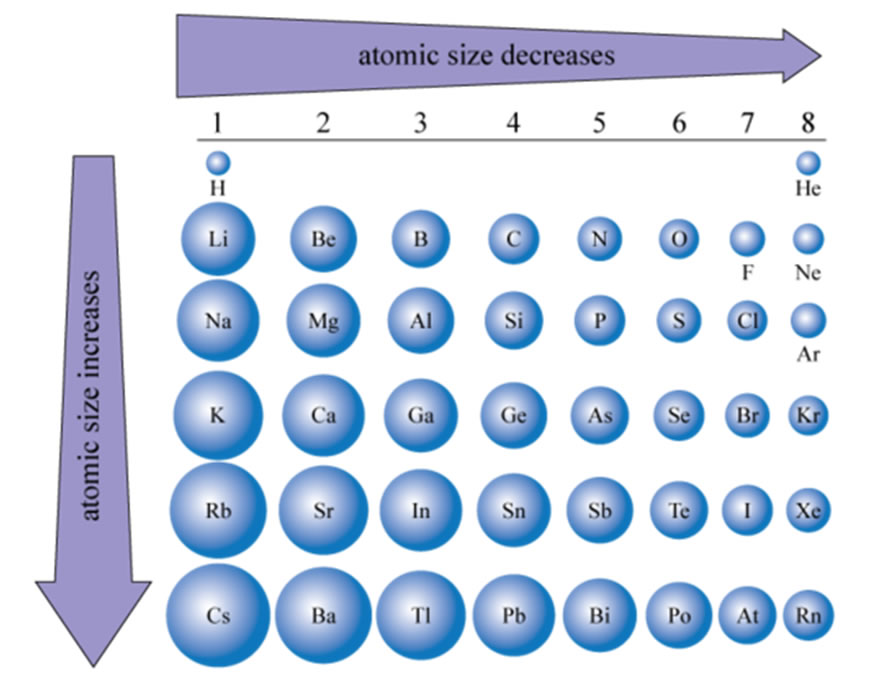
and it's more complicated:
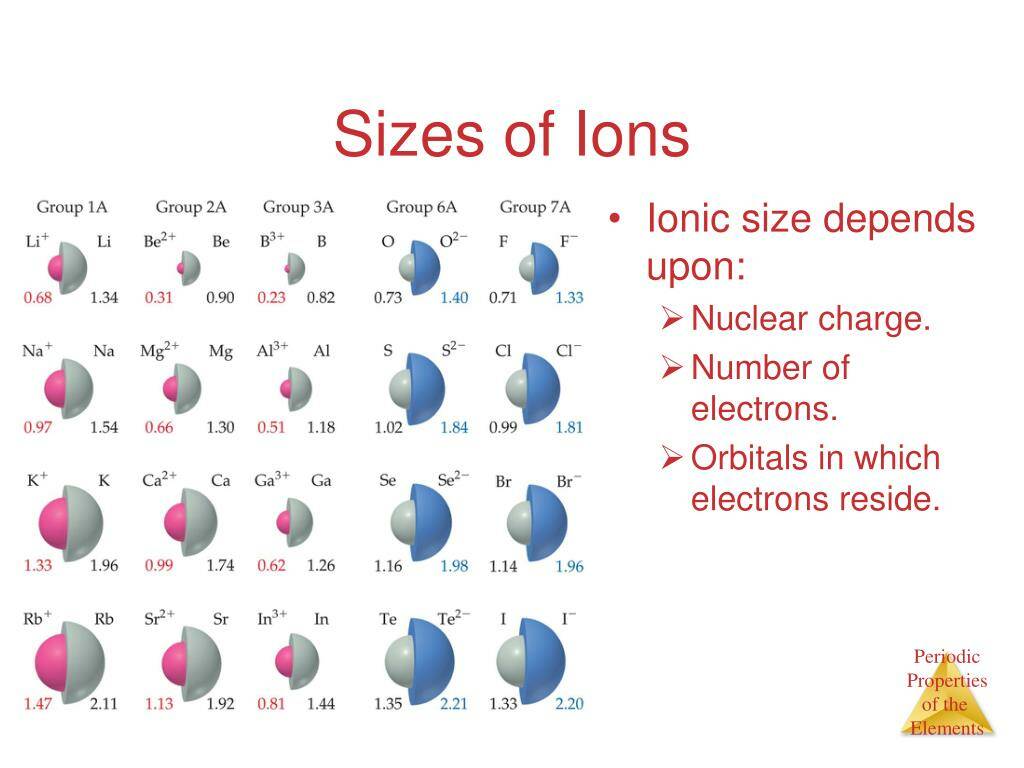
but I have to go deeper in my quest for sizes of particles:
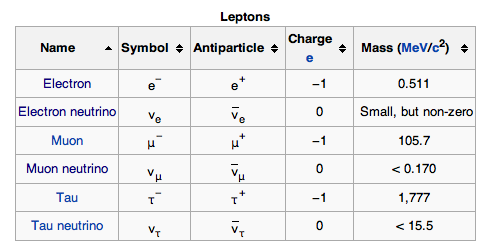
and no answer for that yet, sizes probably vary depending on the atom, but then surely they should exist isolated, and what matters for the size in there is an open question


And now I wonder why this wild offtopic is here. Because my thought went there, cool.
Ab Ad (of to (f t))
Ev Ez (????)
aB aD (of, to (that's latin)) b.. and I've been thinking: how can b correspond to of, if it's in. And to my pleasant surprise it is both:

and it is also by, which makes of and by and в cognates.

and if that protoalphabetic syllabary is in latin, you will find those shorties by clicking the previous images, and meanwhile I found something else:

is Ionic culture the culture of the worshiping Io
is Io showing us the order of the vowels, and that basically there are two vowels and basically they look like 1 and 0, and it is supported by 1-like i being lingual, and 0-like o being labial (0 is odd, because it's an integer of the form 2k, where k=0 (so, by definition, and because it's an integer apart from the odd 1))
And then this is interesting:
ōs
neutral noun III declension
1 mouth, speech, expression
2 face
3 pronunciation
SINGULAR
Nom. ōs
Gen. oris
Dat. ori
Acc. ōs
Abl. ore
Voc. ōs
PLURAL
Nom. ora
Gen. orum
Dat. orĭbus
Acc. ora
Abl. orĭbus
Voc. ora
and
ŏs
neutral noun III declension
1 bone
2 (nut) kernel
3 (tree) heartwood
4 (fruit) stone
5 (dead people) bones
SINGULAR
Nom. ŏs
Gen. ossis
Dat. ossi
Acc. ŏs
Abl. osse
Voc. ŏs
PLURAL
Nom. ossa
Gen. ossĭum
Dat. ossĭbus
Acc. ossa
Abl. ossĭbus
Voc. ossa
these two examples may say that R~S
roll has liquid ll (the l of word liquid, lake, лакай, лижи, л is literally lingua)
rock has solid ck (the ch of hard, камень, rock! and I didn't expect it to ring onto rock back)
рой has aerial
ae (pures)
ri (sonors)
and to my shocking surprise I see not only sons in sonors, but also pares in pures (but I named them pures before I thought of sons, and I did it by obvious reason that these sounds don't have the nasal subsound. And now I can see not only son, but oaålso nose
ae is ea? the ea which is air
ri was found in aerial when the suffix al was removed.
It explains why air even has that r. Because it's silent, but still thought of, for it influences the reading.
(the singing, if we had too two to
greetings from obo.html:
якъ яка яку
илъ ила илу
падежи лишь суффиксы, а суффиксы суть местоимения (pronouns, even if they are post them)
(pro in pronouns is prefix пред which can be from both sides: compare by being both от и об)
но пред это перед, пост = после)
проверка:
я (мя?) мы (ны? (plural form of мя))
меня нас
мне нам
меня нас
мной нами
обо мне о нас
форма нас, повторяющаяся больше чем мне, говорит что мне и меня - одно и то же слово, me
(бросил на половине проверку, не понимая что есть с и м: сей и мой? they and me? нас=наш (где ш притяжательный суффикс, типа русского и японского но, нъ. на (и эти три подобны онъ оно она, так что пока сходится, но ш тогда тоже? то же? ш ~ сей, сё, ся (н = с? оба зяычные язычные
cry ~ carey (caring, carrying) горевать
cabron ~ товарищ ~ comrade (in el enfierno they use this word so often that it is what I thougth, and though the actual meaning is somewhat different, so товарищ could derive from тварь and comrade from cum, who knows, or if that co is co(with) indeed, then probably from мразь or merde)
והארץ היתה תהו ובהו וחשך על פני תהום ורוח אלהים מרחפת על פני המים
תהו ובהו (tohu v.vohu (tohu and vohu)) and my dare guess is they're telling that vowels (the earth denote them) are linguals and labials, and linguals (e, i) come before labials (o, u)
нехай так буде is how g.t translates let it be (which is how it translates нехай будет which it sees as russian because of the verbal suffix. But нехай is ukrainian word, it translates let it be into russian as будь как будет (which is another level of meaning
hands are also heads (my hands (manus ~ my nos (what makes us different from all the animals (hardly have we seen apes in europe, but then apes would be recognized as some бес, which is also humanoid))
b and d looks alike? no wonder, in arabic they're only differenciated by +diacritics.
th t p b
ب پ ت ث and there's also a special case of ن, which is lingual, and has its dot where all other linguals do. Both labial counterparts are پ and that is only persian additional letter, without it, in pure arabic, it's 1 2 3 dots. but then that special case of ن is in arabic too, and even if this letter is literally new, it's in there, and it makes good sense: it's dot's also at the lingual (top, yan) part. Interesting, that for vowels they place yin u at the top. yan i at the bottom, especially because o and u are labial and i e are lingual. Did they try to keep the balance or do they mess with pupils heads from very start. Messing us up
پ • (be be-tálat nóʾaṭ) (be with three dots)
(letter name): IPA(key): /be be ˈtælæt ˈnoʔɑtˤ/
(phoneme): IPA(key): /p/
dual letters: us, up
us demands they as the opposite
up claims that down is до (up is по)
до do to too two
Before writing was invented, songs were literally thoughts. sing is both think and sing.
what is sink? труба? воронка? рог использовался для исполнения музыки, трубы гудят до сих пор, поют.
поёт помнит
ЛМН (ΛMN) make sense if l is I (if L is I, if Λ is И)
ИМN ,and it looks like NIИ, which could that that it is I the ego standing in front of crossed MM:

and then ИMN gives WVW or WMW
WMN
(woman)
WMN (w is the best vowel for this group. й~w (the two short ones both are the final two w and y)
aeiou wy are they those legendary seven?
y i e a o u w
and a couple of other candidate mantras:
y i e o u w a
a y e i o u w
i y 3 o u w a
i as 1 is better
if i = I, y = II, E looks like 3
u as 5 is great
w as 6 is good: it looks like ש
A and 7 are both holy, and now I can see their graphic similarity, 7 aa Ʌ and sometimes they have dash. And that dash thing relates A to f, t, z (and it does remind z also as az, the russian obsolete name for it)
And I only didn't tell of 4 the o, and though now I can see the similarity of 4 and o, and now I see 4 as a half of 8, and though arabic confused me (is v vier or vijf issue)

it is not a coincidence their 4 looks like 3, it shows where the shift happened,
and it was sanskrit, the indoeuropean culture, which correlates my find:

the hindu and the medieval font pay attention to. The medieval 4 I had in my mind, when I thought of o, but hindu version is even closer to russian o the ꙋ (minuscule of Ꙋ ..does that v-like shape make that letter double, as u is double o sometimes)
Looking at arabic digits, I thought of how 2 and 7 reflect each other, and both have three letters after them, breaking thus alphabet, and how three and four look alike (not two and three? no, their three and four both remind 3 (their 2 reminds our 2 if we rotate the text so that it will be going from the top to the bottom, in chinese way. Only then lines will not go chinese way, but the other way around (latiin-like alphabets correlate to chinese better. when it's rotated, the columns then go right to left as in chinese) and how seven and eight look alike, and it reflects (reflexes) три и четыре being similar to another pair: семь и восемь (as if 3=З[z] фтв 4= ž[ʒ]) and then is 8 just double 4 and was added to the canon later? did 6 and 9 play better role?
how could brahmic 2 become 5 in arabic? because areabic is read the other way around.
in hindu ३(3) and ६(6) reflect each other, which contributes to the 6 and 9 reflecting eachother.
and २(2) and ५(5) reflect eachother too. which definitely relates to 3/6 similarity, but that is it.
०१२३४५६७८९
but then 6 and 9 are similar only in lating numerals, so I have to look around for more fractions of the protosystem. But no, let's leave it all to ai powers.
Chorus ~ Horus ~ Kronos ~ Chronos (sun raising at the sky as the measure of time)
and the story about eye of Horus may be reflected in the story about Ódin (Odín is one in russian)
And those stories (or rather that story) could refer to the sky being the eye of a god, and moon then is the dead eye.
Monkey is a little monk?
? Mon key (мои ключевые(основные) (черты))
? Monk монах
money ~ монета (ос ло от слова менять? в английском от слова mean (средство, например оборотное) означать, и в размене монет эти два значения слились в общее семантическое поле, будучи его отростками (быть может, аксонами реальной нервной клетки? And I had some mellow feeling from a front top of my head, I waved hair by a hand (that чуб) and it went)
MLN molin (мельня (мельница)) the cross of it's fan, the quadrant it makes, geometry is where engineering begisn)
LMN where L is I and the I is ا which links Λ to Α
ΛMN the amen. amt is truth, amen is true, I guess.
if elements are named after this very sequence, then this sequence is representing, symbolizing the elements. M is water, N is what? nani yo! A is air?

playing this autistic game I went so deranged that I started feeling as if I hold it upside down, that those are not d's but p's (not daddy but papa?) and I had some wild ideas about it, one of which was that if e is ə, then d is p, then ə is o, then b is q, which is only natural after p, and then it tells me two things: opq is the bde read in reverse (on inhale? voiceless is easier on inhale (in inhale speech voiceless sounds come easier) and the thecond thing it tells me: when there was no cd distinction, they both were ч of a kind: and h maybe too, and thus.. well, it's all crap, but interesting, it could be even true.
I saw it as in reverse because it activated my tetris almonds, and in tetris figures fell from atop.
And it is interesting how I sorta broke through from k they went to M (millions) then to B (billions) and I expected T after that, but they gave me a, and went on b, c, d, etc.
And yet of course it is arbitrary and has nothing to do with the alphabetic structure used as
abde
ft
a b d
e f t
The sublime difference between S a nd T is also seen in grammatic forms in russian:
что делает ~ что делаешь
suffix т is of тот (that)
suffix s is of Zie, cии
Imagine if german grammar uniquely capitalizing mouns (ma names)
this and that are these elements in english.
I need glasses, because I smirk my forehead to focus. I need glasses or close my eyes not to allow this cascade. Or has it already started once I felt it? I now can llearn to stretch it back)
I think I succeeded in what I wanted to do in the previous chamber, because I stretched it and until (and is a typo of until, unt is and, I suppose, and il (russian ili?)
NOw I type with my eyes closed and I now trust in me to write in tnglish or russian cyphered.
Some russian texts, unless I learn to switch and fail odd number of times. odd ~ and. With my eyes colesed I can see claearlty now...
изъявительное, сослагательное, филология одним лишь этим уже вымораживает. по русски говорите русский человек.
читать чтоб (чужие тексты, как вот это сейчас (что есть "еси")) открыл глаза читая. Надо читалку.
лесина is a jewish name (as if she's not левина, as she's not леви)
ленин chose this pseudonym to imitate
grade grain, grape and grapefruite.
grain and grape are such basal cultures, and they are such similar words. as if that gr is жр (жри = devour, much shorter (much basal) in russian it is.
as if p of grape is p in пить [pitt] (to drink)
to drink = do drink. That is why I felt the connection immediately, mostly due to russian -ть
The next image, what they ment by it I don't know, but it made it clear that dogs can show these two words by their ears. Is it why yes ~ pick up, and no ~ put down?
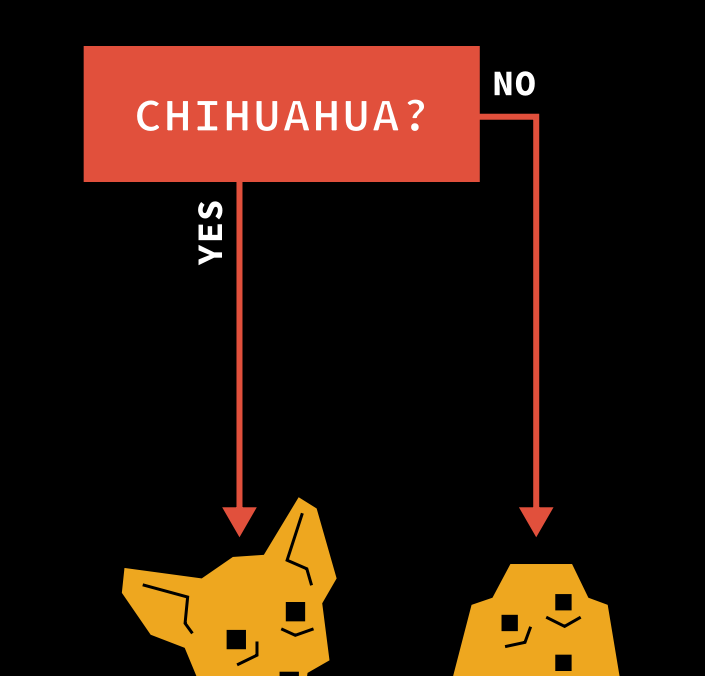
there was some language, which I felt to be a brainwashing campaign, when they made me push "no" at "beard" even though it didn't have any other option, and though it was part of the lesson, I felt an unease.
And for whatever reason, this page started lagging few days ago, and it started at once and severly, and whatever the isuse is, I have to switch to another issue:
viol.25
...
